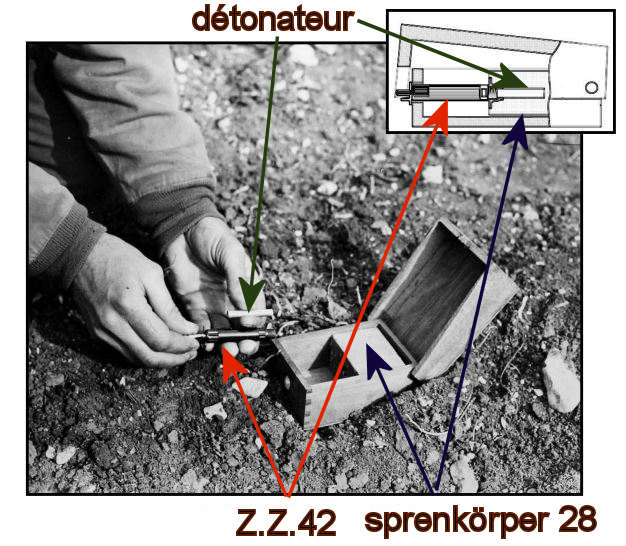Renée Marie Marguerite BURGERT(1935 – 2018)
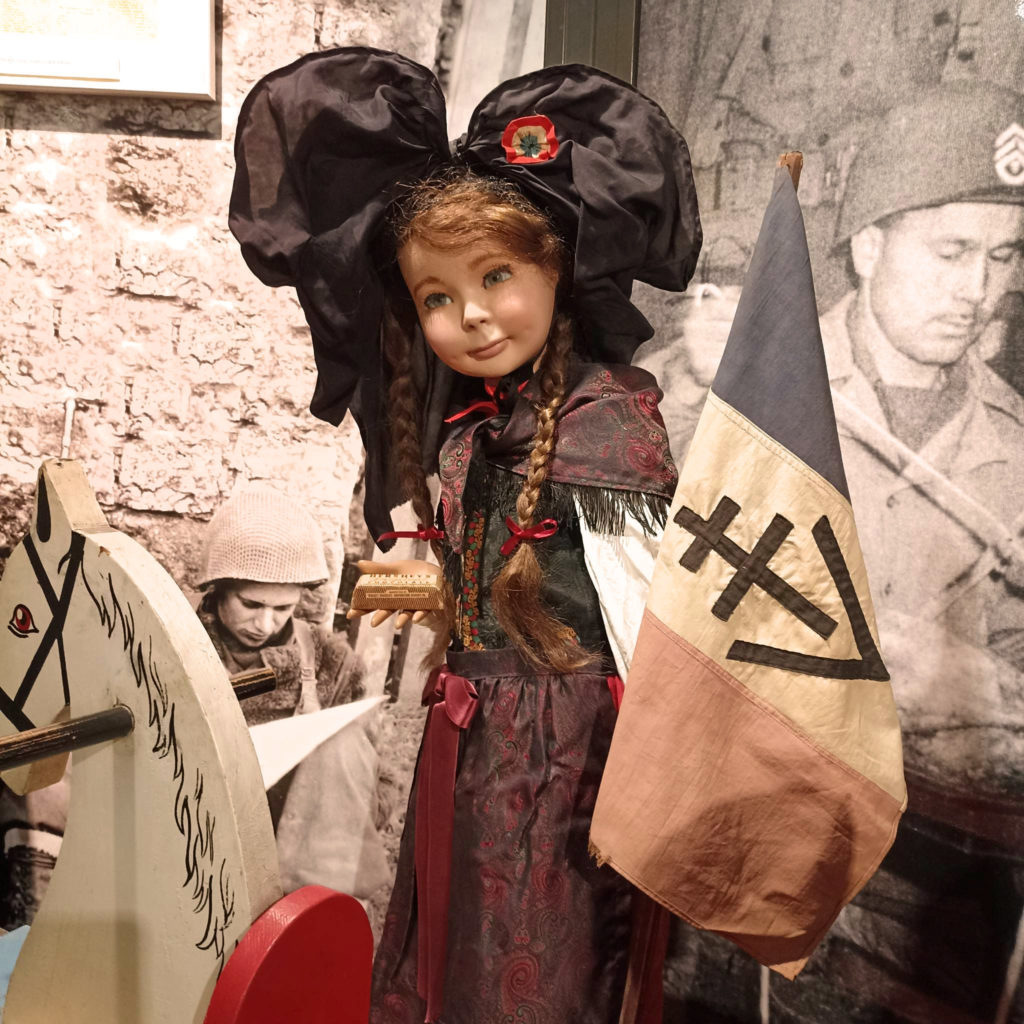
10-year-old Renée Burgert in traditional Alsatian dress at the liberation of her native village of Walbach(68) in the Munster valley on February 5, 1945.
She was born on November 22, 1935 in Walbach and died on May 14, 2018 in Trois-Epis Ammerschwihr(68).

Joseph OTOROWSKI 1927 – 1945

Joseph was born on February 22, 1927, at 33 route de Bâle, Colmar (68).
Of “unknown” father, he was recognized by his mother, Eléonore Otorowska, on March 14, 1927.

We know nothing of his life, and the only information we have comes from his military service book and his citation, found by Mr. Walch Maurice of Hirtzbach at the Altkirch (68) landfill site, which he passed on to the Jebsheim (68) commune.
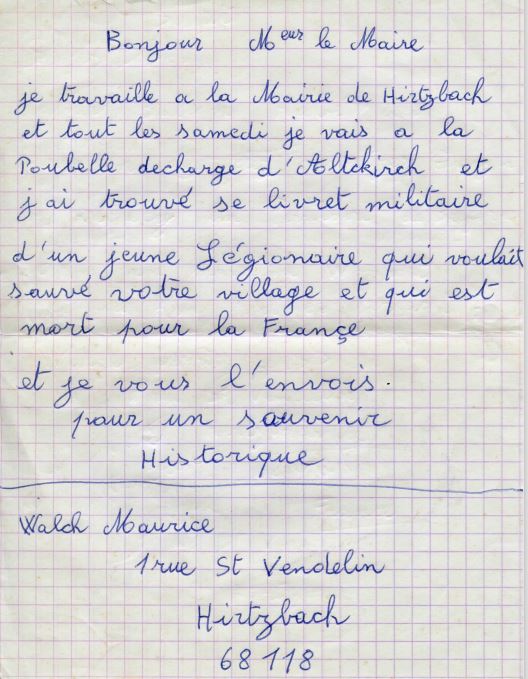
On the 4 documents we have of our valiant soldier, his name is spelled differently each time 🙂
On November 23, 1944, he voluntarily enlisted in the Foreign Legion with the Régiment de Marche de la Légion Etrangère (RMLE) under regimental number 19937.
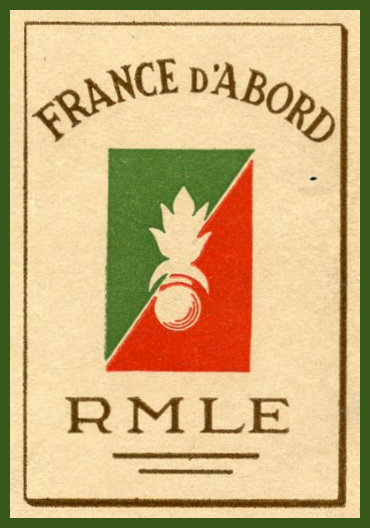
His passbook states that he is of Swiss nationality and that he lives in Champvans in Haute-Saône (70).

He was assigned to the IIIrd Battalion in the 11th company of the Régiment de Marche de la Légion Etrangère (RMLE).
During the fighting for the liberation of Jebsheim, 2nd Class Private Otorowski Joseph was seriously wounded on January 29, 1945, with a penetrating wound to the left hemi thorax.

He is evacuated to the HEM412 (Military Evacuation Hospital) in Besançon(25).
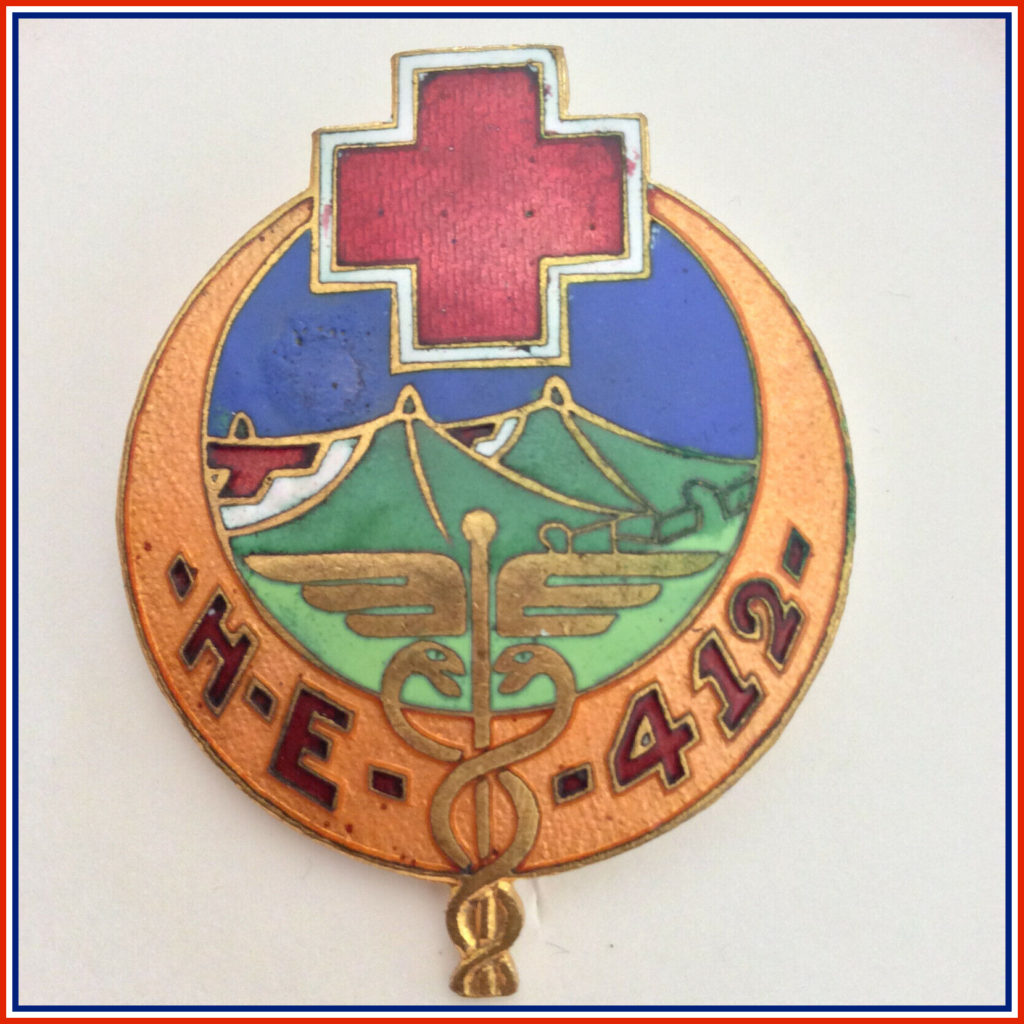
He was evacuated to another hospital on March 30, then transferred to Marseille on May 1, 1945 and admitted to the “Clinique Moderne” supplementary hospital (this may have been a temporary army hospital opened for the duration of the war, to increase the number of beds and the number of treatments available to complement existing civilian and military hospitals), where he died of his wounds on May 30, 1945, aged just 18.

For his action in the fire on January 29, 1945, he was cited in the regimental order:
“Young legionnaire, courageous and full of spirit, was seriously wounded on January 29, 1945 while taking up a position on the eastern edge of the village of Jebsheim”.
This citation includes the Croix de Guerre with bronze star 1939 – 1945.
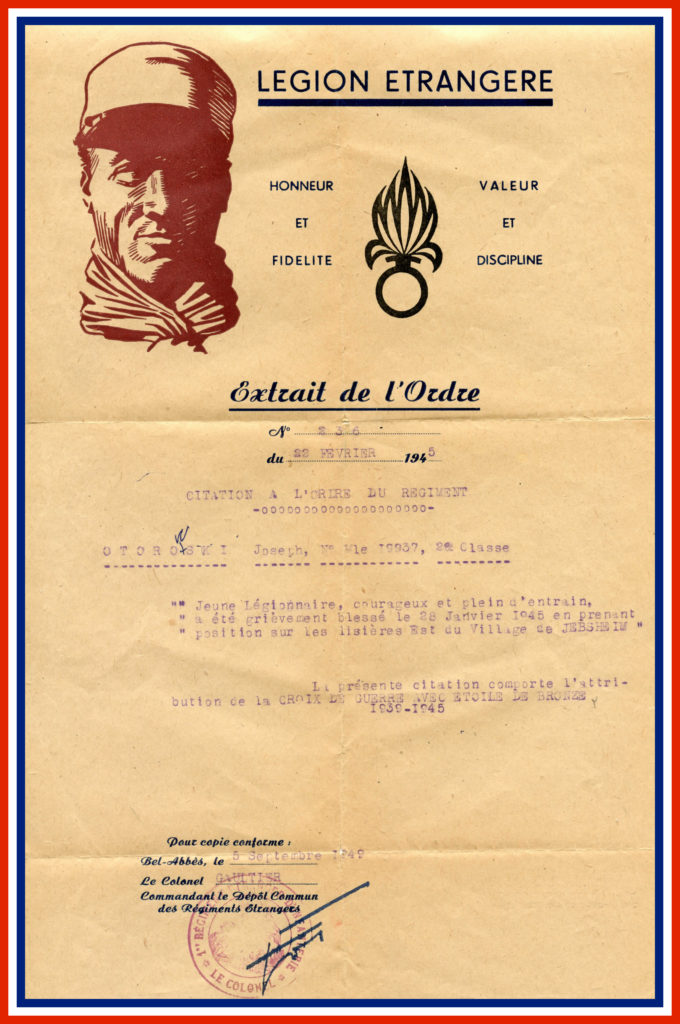
We would like to warmly thank the Mayor of Jebsheim, Mr. Joël HENNY, who kindly lent us these documents and opened the town’s archives so that we could tell its story and share it with as many people as possible, as well as the municipal staff for their invaluable help.
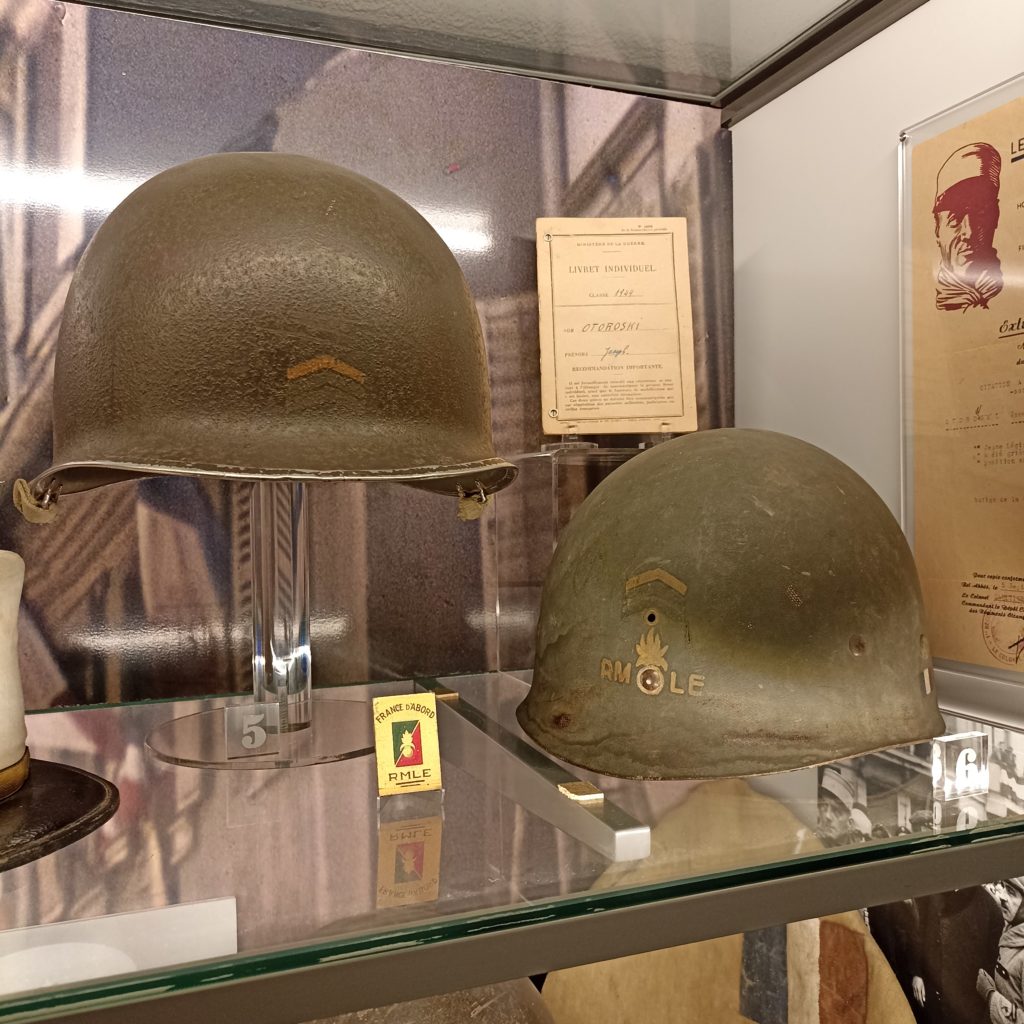
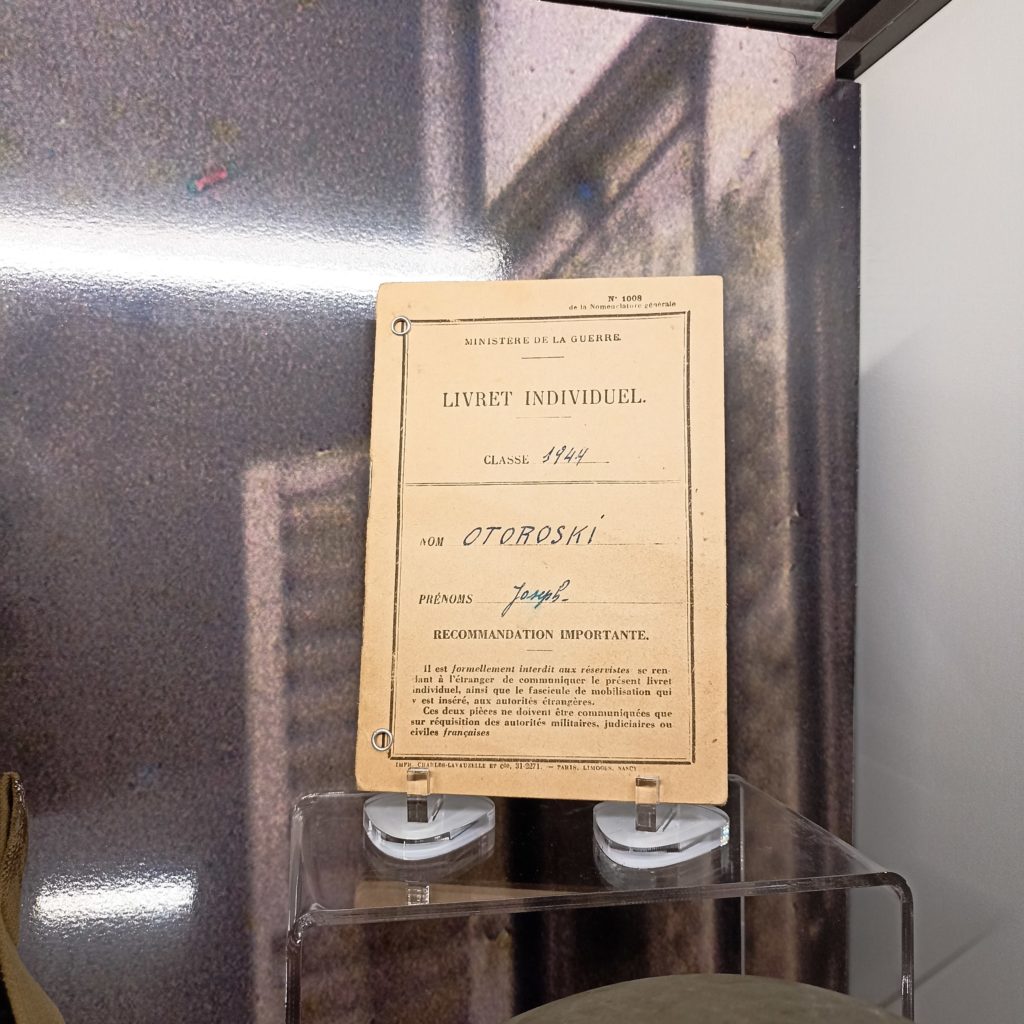
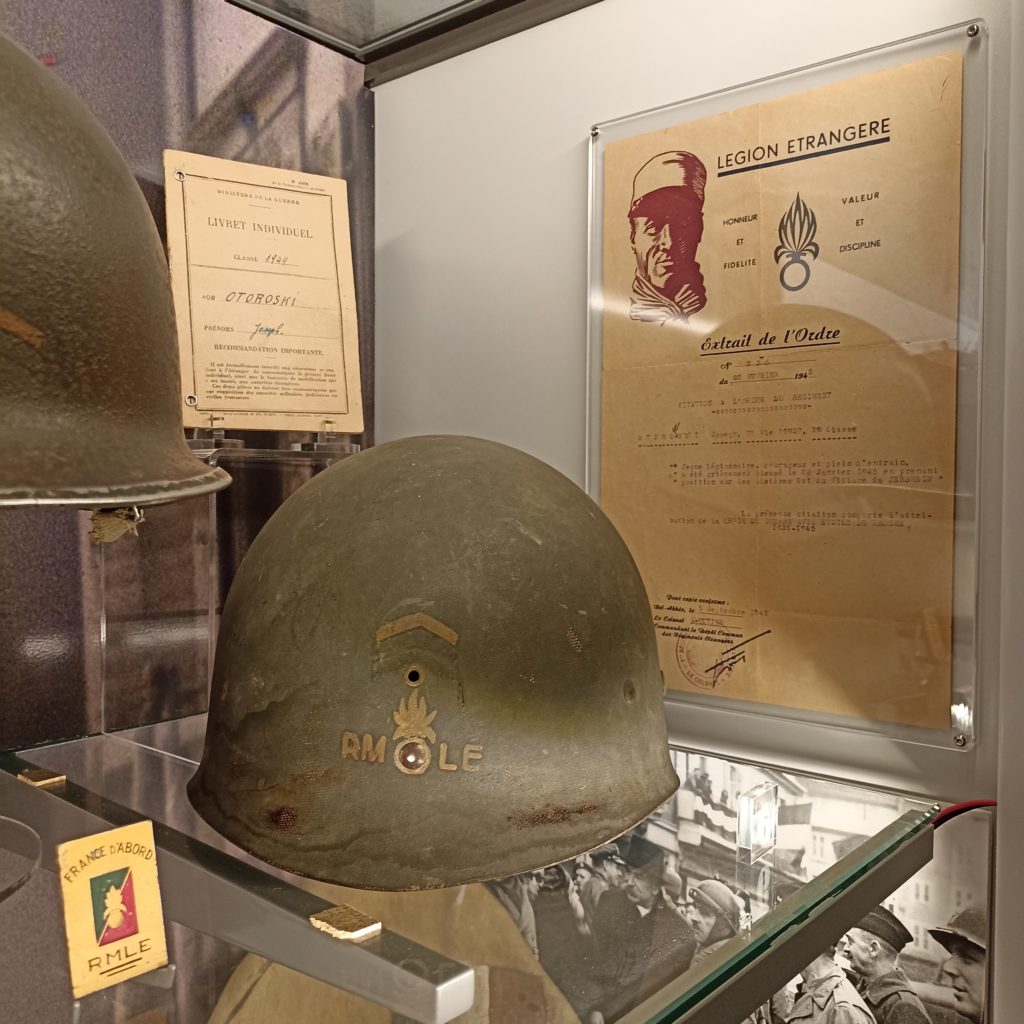
Jean AUDEBERT 1911 – 1975
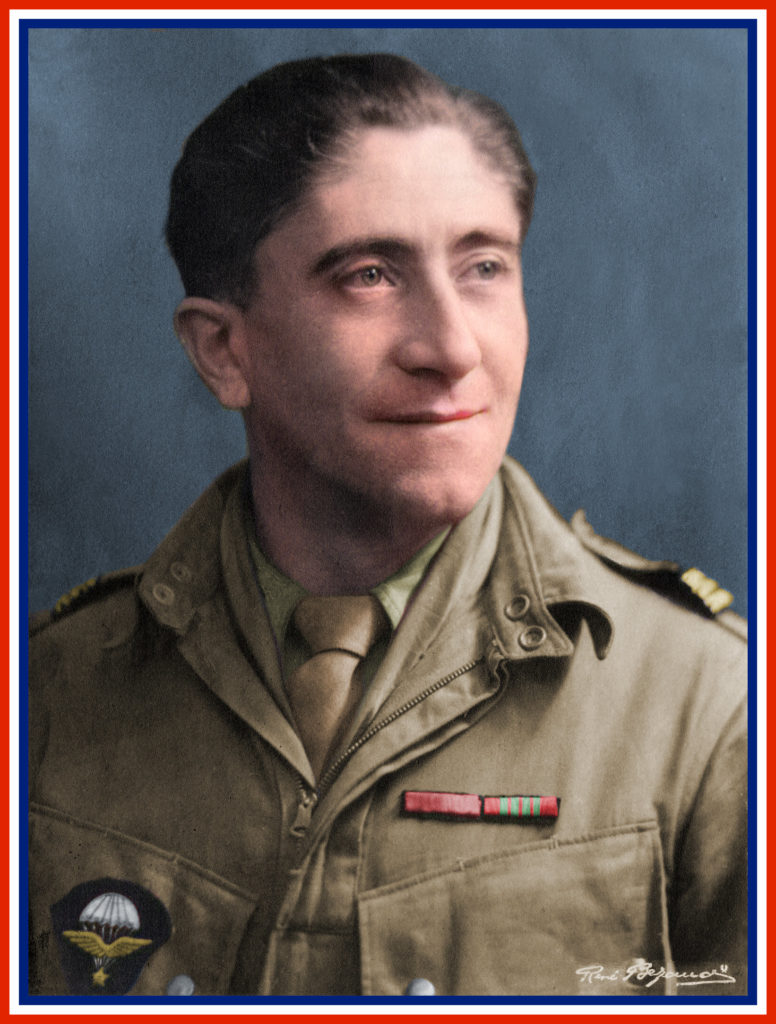
Jean Audebert was born on March 20, 1911 in Poitiers, Vienne.
He spent his teenage years in Royan (17) until his baccalaureate, when he attended a preparatory school in Bordeaux (33).
Volunteered for 8 years at the Ecole Spéciale Militaire (St Cyr) following the 1931 competitive examination.
He was preparing for the navy, but entered St Cyr with the “Tafilalet” class of 1931-1933.
Jean was very sporty: swimming, tennis and he was part of a volleyball team that played on the big beach at Royan.
At St Cyr, he was a member of the rugby team.
Below with his team (squatting, second from right).
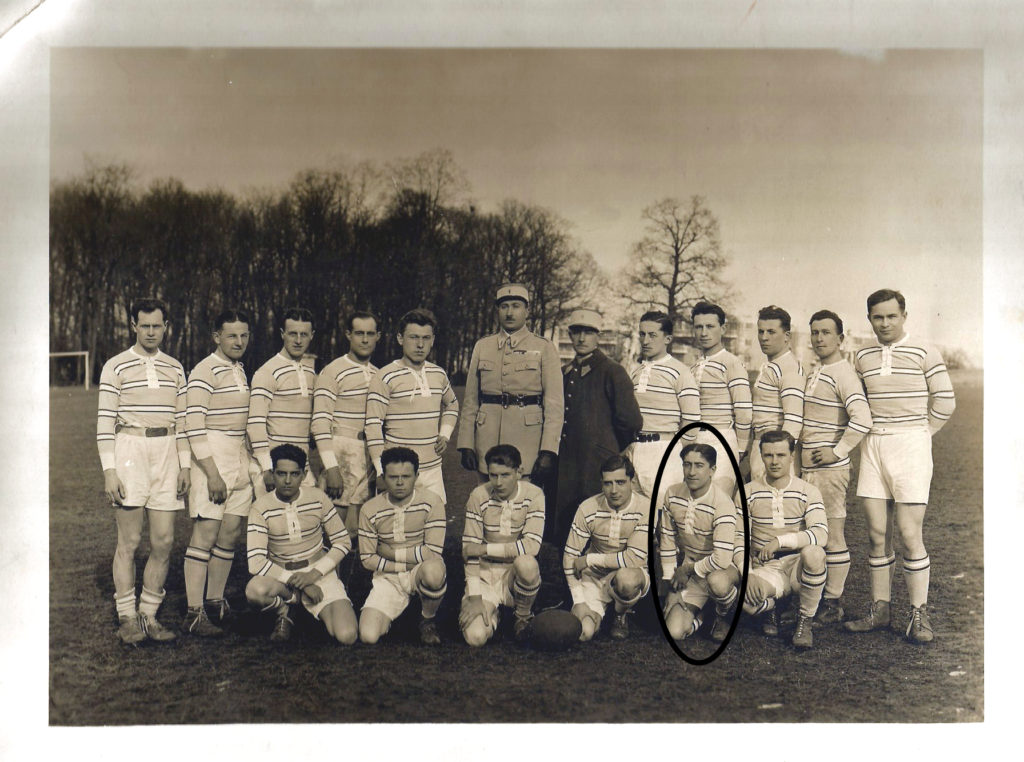
On October 1, 1933, he completed his studies and left St Cyr with the rank of Second-Lieutenant.
He was posted to the 141st Alpine Infantry Regiment (141ème RIA) in Marseille, and detached to Draguignan on the 18th. A good skier, he commanded the scout-skier section. He was promoted to Lieutenant on October 1, 1935.

In November 1935, he responded to the call for applications for the first training course for French paratroopers. He was selected and temporarily seconded to the Armée de l’Air, at the Centre-Ecole d’Istres in late 1936. Istres was too windy, and the trainers decided to move the course to Avignon Pujaut, where the weather conditions were better.

Jean Audebert (still wearing his chasseur alpin “pie” on his head) on his arrival at Avignon-Pujaut with the other officers of all arms in November 1936.
Jean Audebert equipped and ready for a jump during his training in early 1937.
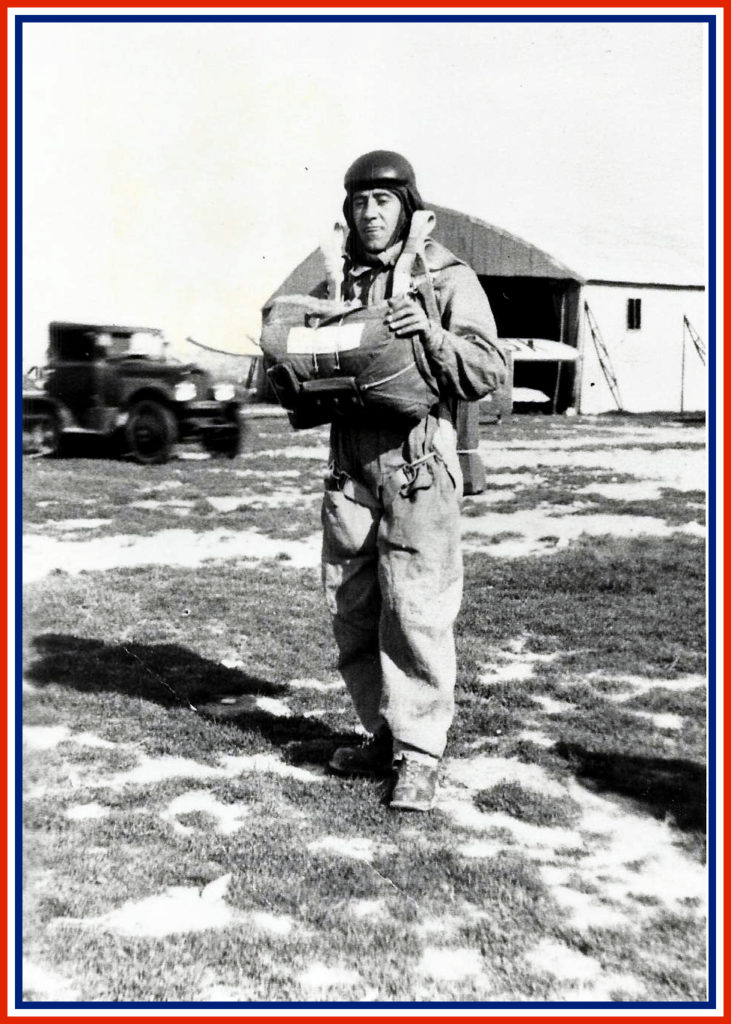
… Extract from his jumping notebook in February 1937 at Avignon-Pujaud…
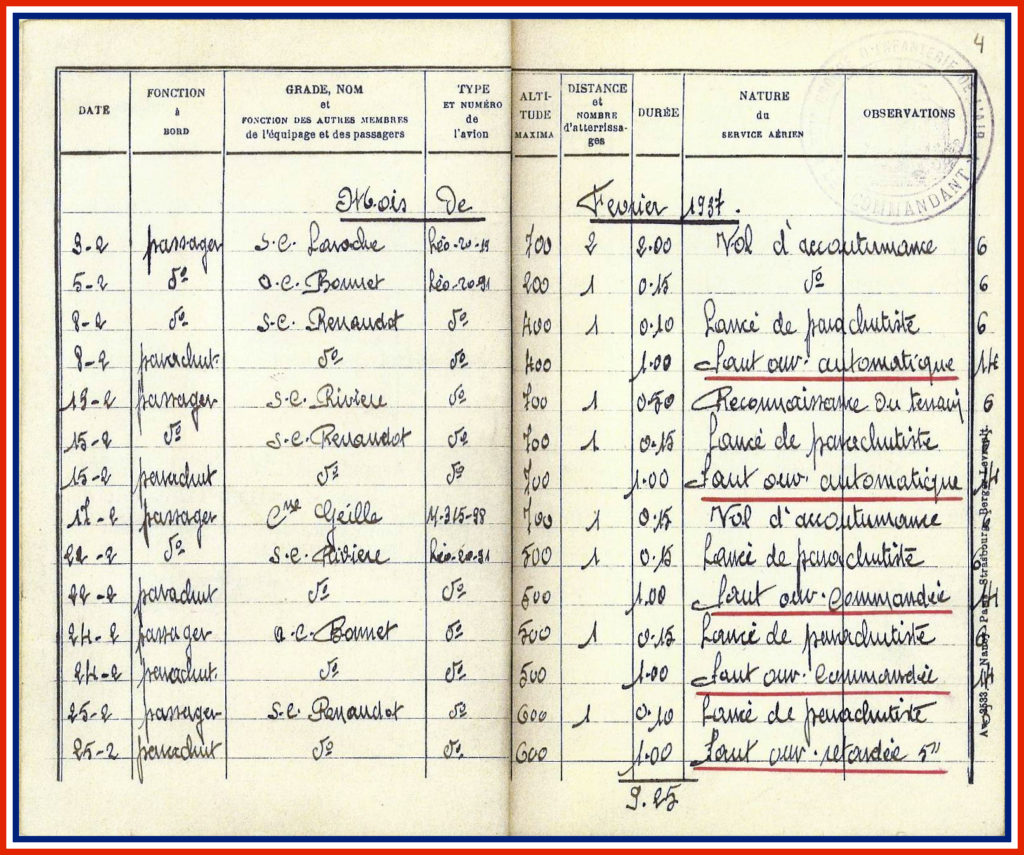
..Group photo during the course with Jean Audebert in aviator’s outfit on the right…
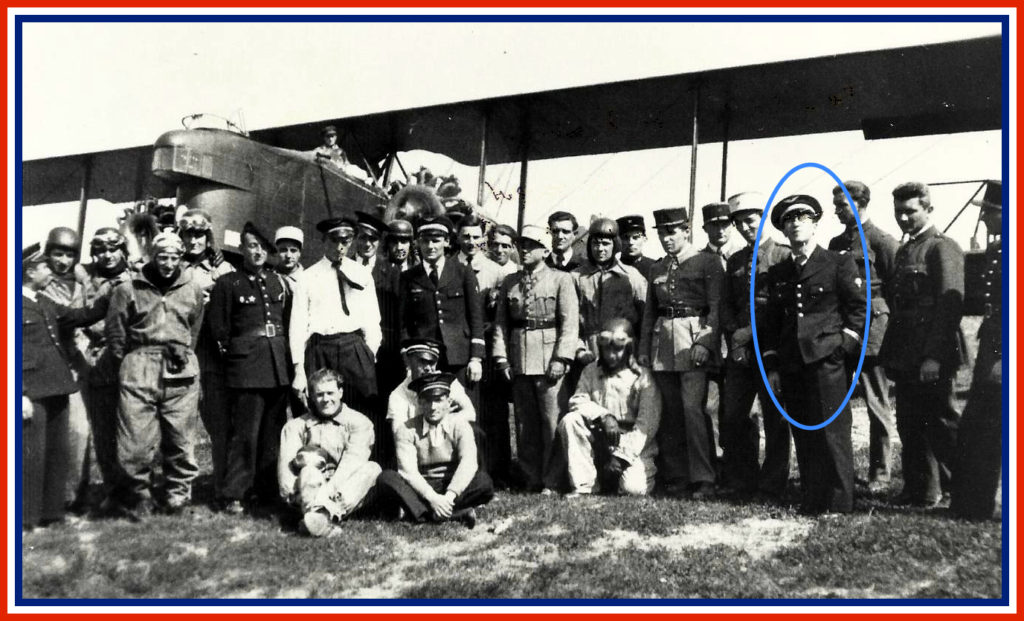
…He obtained the Brevet Militaire de Parachutiste de l’Infanterie de l’Air n°4…French Paratrooper Badge number 4…
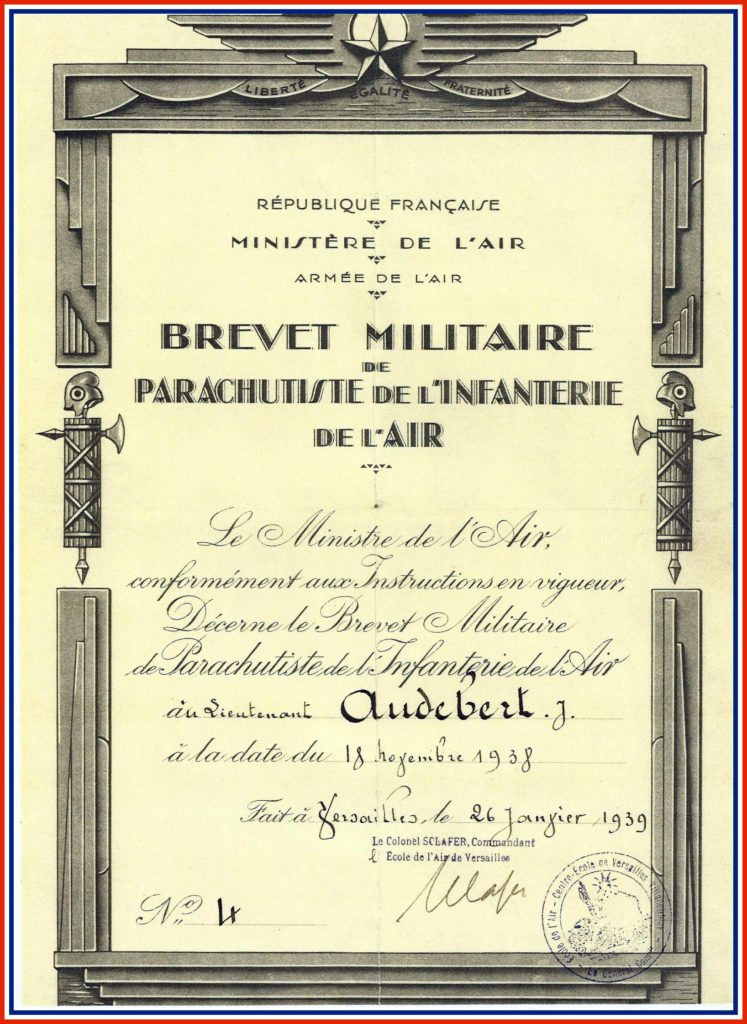
…shown below at the end of his training course with his friends Lieutenants MAYER (brevet n°8) and FOUCAULT (brevet n°14)…
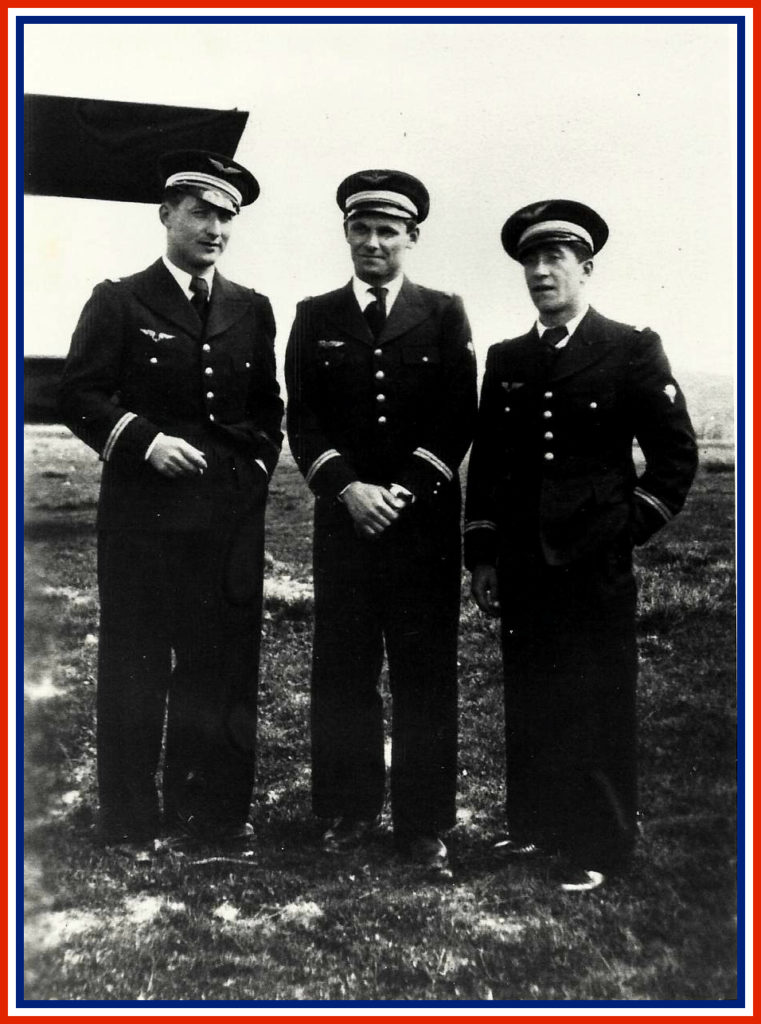

He joined the 601st Groupement d’Infanterie de l’Air (601st GIA) in Reims on April 1, 1937.
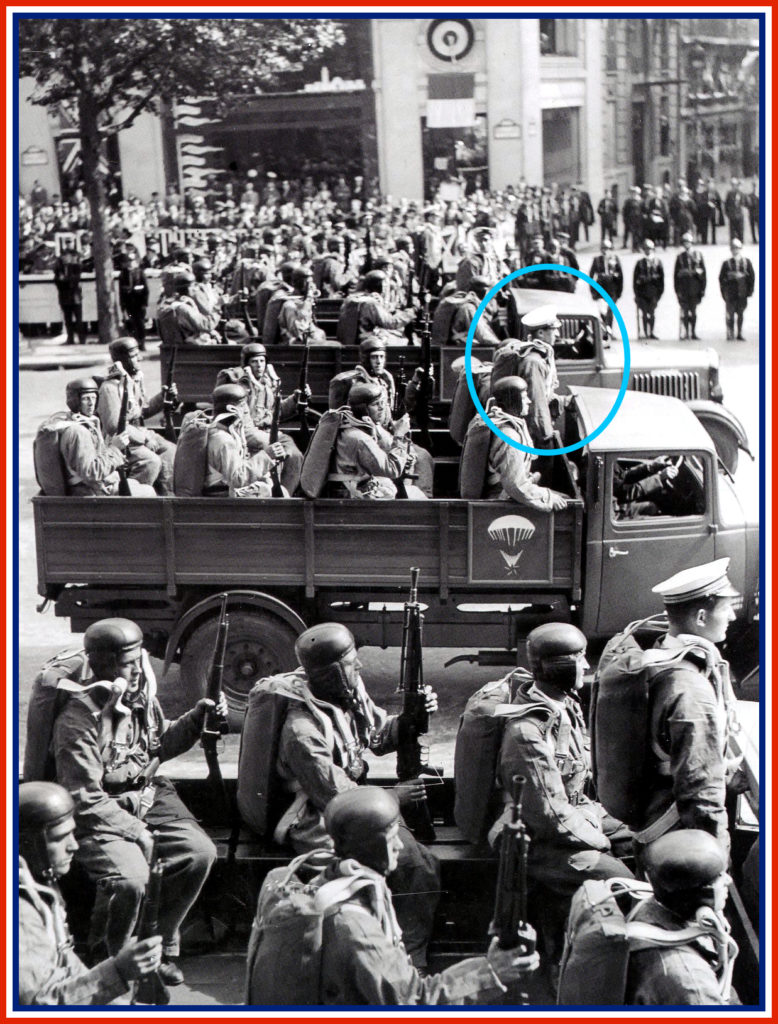
Seconded to North Africa, he landed in Algiers on March 5, 1939.
Due to general mobilization, he returned to France, arriving at Istres on October 2, 1939.
He joined the Corps Francs formed from the Air Infantry’s 1st March Company, and took part in operations from February 14 to March 11, 1940, in the “Alsatian no-man’s-land” between Lembach and Obersteinbach (Niederbronn-les-Bains sector, Bas-Rhin).
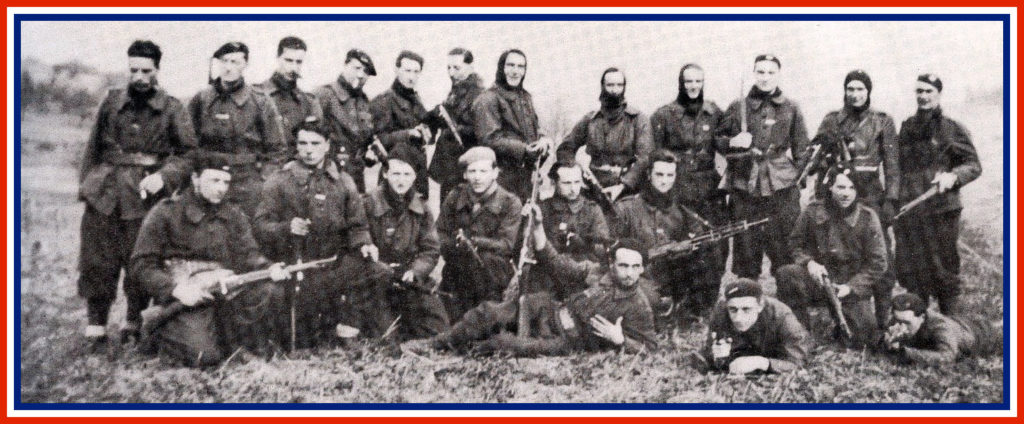
On March 15, 1940 he was promoted to Captain.
He was first cited in the order of the 55th Alpine Infantry Brigade by decision no. 49/59 of May 8, 1940:
“Officer of rare intrepidity. Always ready for dangerous missions. Commanding an Air Infantry section, for 3 weeks he took part in all the reconnaissance, patrols and ambushes carried out by the Free Groups of the 1/165th R.I.F. and the 27th B.C.A., gathering valuable information for the command. On February 17 and 18, during a lively close-range engagement with an enemy patrol, showed absolute disregard for danger and grit under automatic weapons fire”.
This citation includes the Croix de Guerre 1939-1945 with bronze star.
After the defeat of June 1940, he was transferred to Groupe Aérien 1/38 on August 26, then to BA 117 at Aulnat on September 12, 1940. At the beginning of 1941, he was attached successively to the BA at Salon de Provence, Orange and Toulouse-Francazal, before being posted on October 10, 1941 to Compagnie de l’Air n°1 stationed at Oued-Smar (eastern suburb of Algiers), where he joined his former comrades from the Groupements de l’Infanterie de l’Air (GIA).
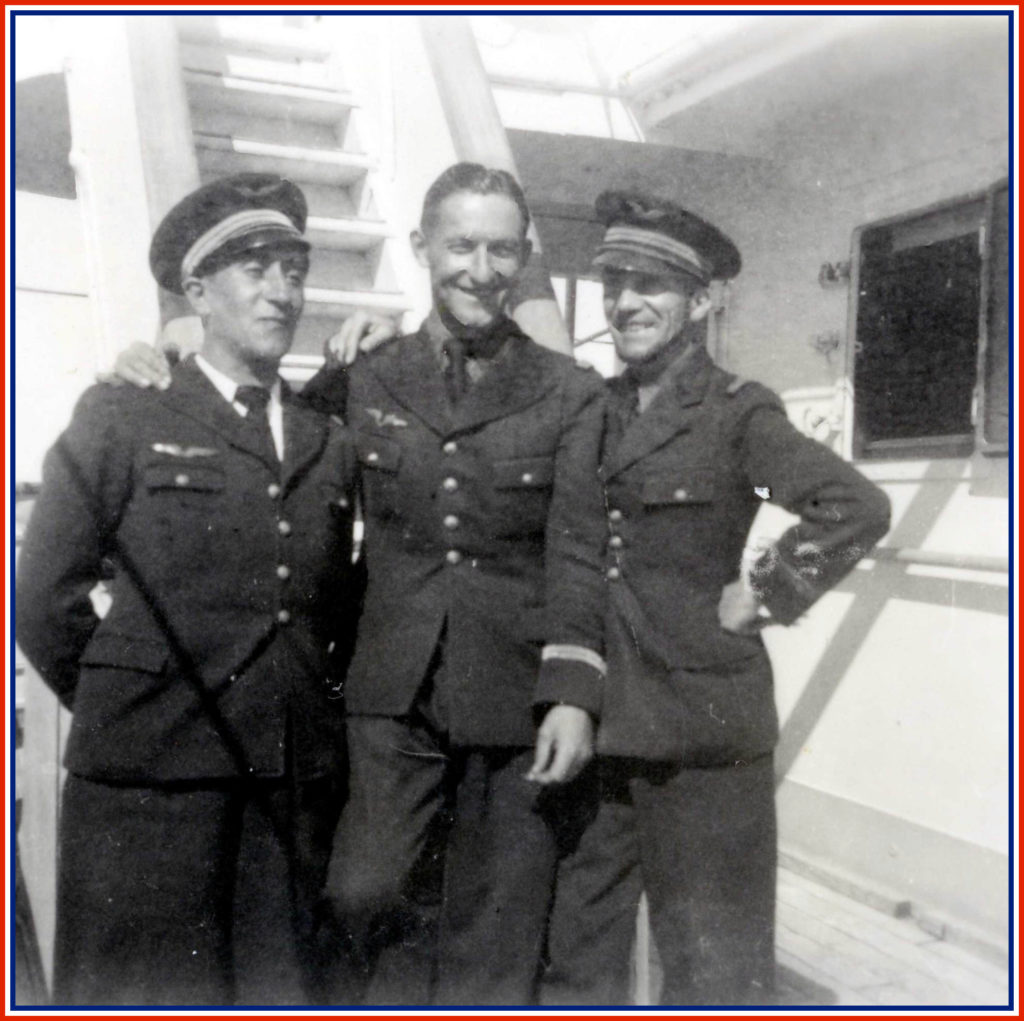
On February 1, 1943, he was assigned to the Bataillon de Chasseurs Parachutistes n°1 (BCP n°1) in Fez, Morocco, which officially became the 1er Régiment de Chasseurs Parachutistes (1 RCP) on June 1, 1943.
On June 1, 1943, he was appointed to command the “Depot Ecole” (training center), a compulsory step for all young recruits wishing to become valiant parachute hunters.
He moved from Fez to Oudja on October 7, 1943, and settled with the regiment at Camp des Anglades to attend the famous and dreaded American Airborne Training Center (A.B.T.C.), supervised by the “All Américan” of the famous 82nd US Airborne Division.
On December 3, 1943, the entire regiment jumped into the Nemours sector in Algeria, the 1st RCP now well trained, equipped and ready to do battle to liberate France.
On December 20, 1943, the 1st RCP leaves Oudja and moves to Félix-Faure for the 1st Battalion and Bordj-Menaiel for the 2nd Battalion.
Jean Audebert left Algeria with the 1st RCP on April 9, 1944, landing in Trapani, Sicily, where training would continue.
He arrived in Rome between July 7 and 11, 1944, where the 1st RCP celebrated the 14th of July with a parade and an audience with Pope Pius XII, who received the Regiment’s officers and volunteers.
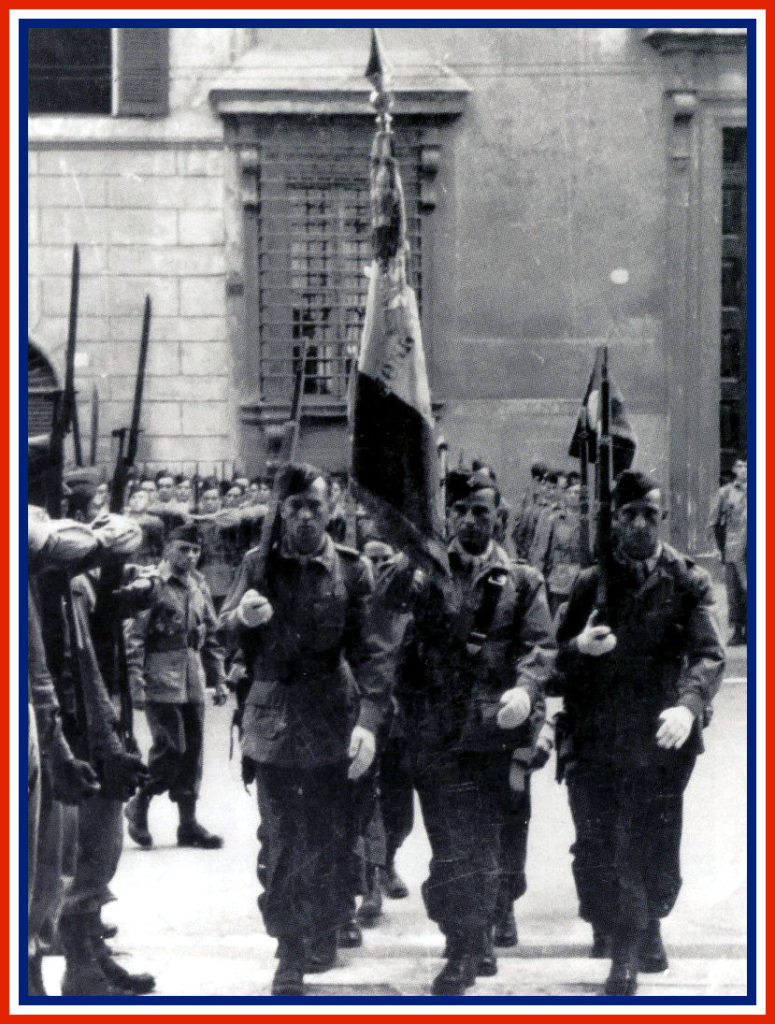
September 5, 1944 was a great day for Jean Audebert and his brothers-in-arms: the chasseurs parachutistes landed at Valence-Chabeuil in the Drôme region and set foot on the emotional soil of France, which they had just liberated from the Nazi yoke.
From September 28 onwards, the Regiment left Valence to reach Fauconney by road at the beginning of October… the terrible Vosges campaign was about to begin.
Jean Audebert begins this campaign as an assistant officer on the Regimental Staff.
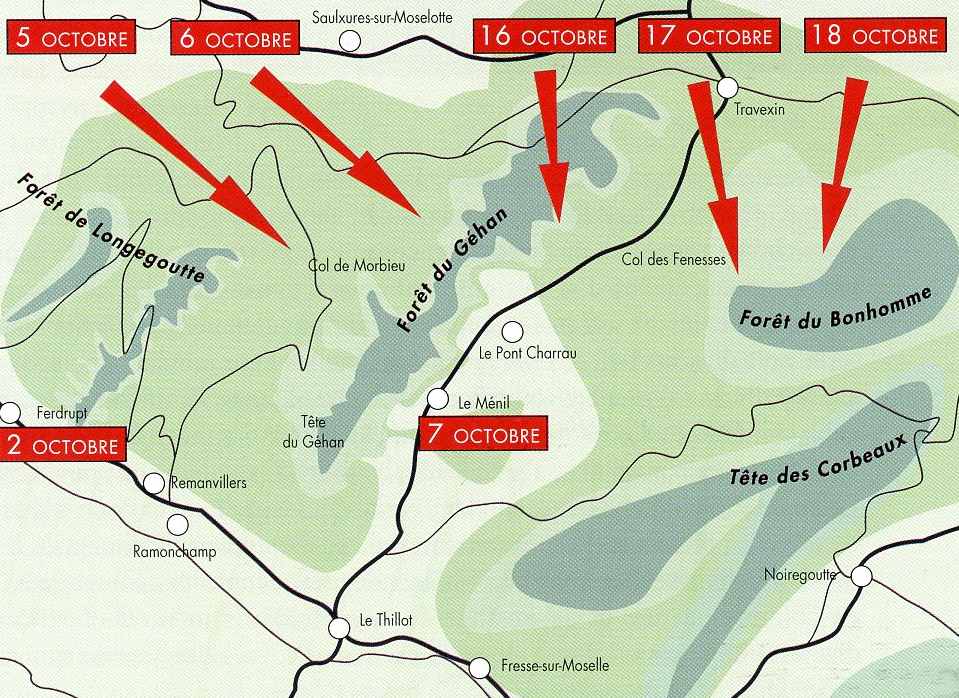
On October 8, 1944, Captain Chevalier’s 8th Company set out to capture the village of Ramonchamp. At 10 a.m., when Captain Chevalier and his group entered the Joly farm (Hameau de L’Etraye), they came face to face with around twenty German soldiers, whom they neutralized. Seeing the rest of the Germans flee into open terrain, Captain Chevalier stepped out onto the porte cochère to call for mortar fire from the mortars he had had placed in a clearing a little further up: it was at this point that a German machine-gun in position to protect the farm opened fire, fatally hitting the Captain, who collapsed in front of the entrance. That same day, the 8th company also lost its first officer and 7 parachute chasseurs (plus a dozen wounded).
Captain Audebert was given the tough task of succeeding his friend and commander of the 8th company (in tribute to his leader, the company has since been called “Chevalier”, with a knight’s helmet as its insignia).
Lieutenant Audebert went on to fight with his company in the Gehan forest, the Morbieux pass, Travexin, côte 1008 and 1111, and La Malcoste. After 3 weeks of bitter fighting, the 8th company left the sector on the night of October 24-25, 1944, and joined the rest of the regiment at Saulx-Les-Vesoul to rest and reorganize.
Previously known as the “Compagnie Chevalier”, the rest of the regiment nicknamed it the “Compagnie Audebert”, after its new captain.
In homage to Captain Chevalier, the men of the 8 added “Compagnie Chevalier” to the regimental pennant.
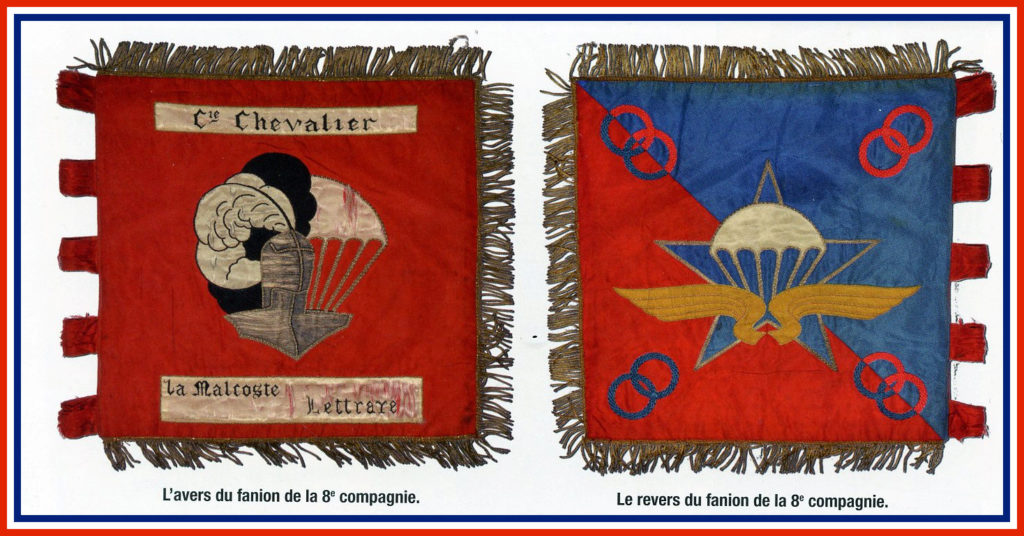
In less than a month, the 1st RCP lost 129 men and 34 officers, 57 non-commissioned officers and 248 chasseurs were wounded, representing 40% of the unit’s strength.
For his actions in the Vosges, Captain Audebert was cited in the Army Order with the Chevalier de la Légion d’Honneur Cross:
“Remarkable company commander, took by surprise on October 16, 1944 the village of Travexin strongly held by the enemy. On October 18, in a bold maneuver, seized the Malcoste farms and the heights overlooking Travexin, thus opening up a particularly important supply route for his regiment. Disrupted the enemy’s system, forcing them to abandon the Daval and an anti-tank ditch. Took 36 prisoners, 3 anti-tank guns, 2 heavy machine guns and numerous automatic weapons from the enemy.
On December 7, 1944, Jean AUDEBERT and his regiment headed east into the Colmar pocket, arriving on December 8 at Gerstheim (67), south of Strasbourg.
He took part in the entire Alsace campaign, leading the 8th company, fighting at Friesenheim (67), Orbey (68), Jebsheim (68) and Widensolen (68).
On February 20, 1945, it left Alsace in a road convoy with the 1st RCP for Lons-le-Saunier (Jura), to take a well-deserved rest after the bitter fighting in the Colmar pocket, where 176 of their number were killed and 512 wounded – 60% of the regiment’s strength.
On April 4, the 1st RCP moved to the Avord air base in the Cher department, to complete its manpower and commission the parachute chasseurs who had not yet done so.
Jean Audebert was seconded to the 24th Airborne Division headquarters on August 28, 1945.
He was promoted to Battalion Chief on December 25, 1945.
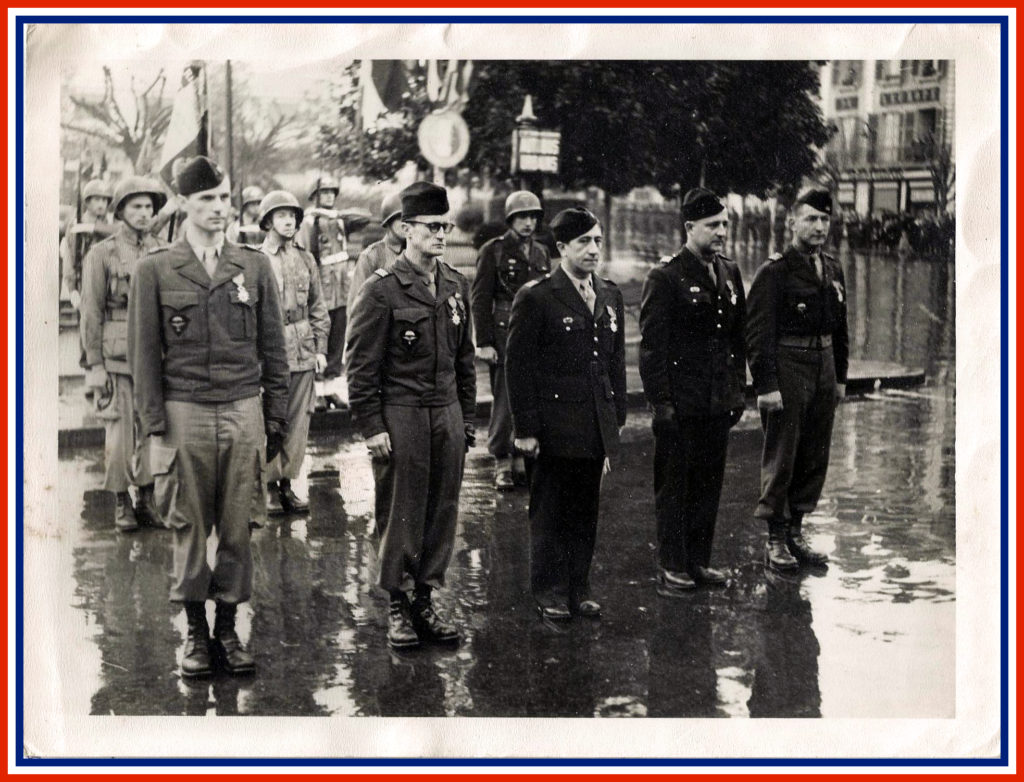
On February 16, 1946 he was transferred to the Lindau Air Support Training School in Bavaria (Germany) as an instructor.
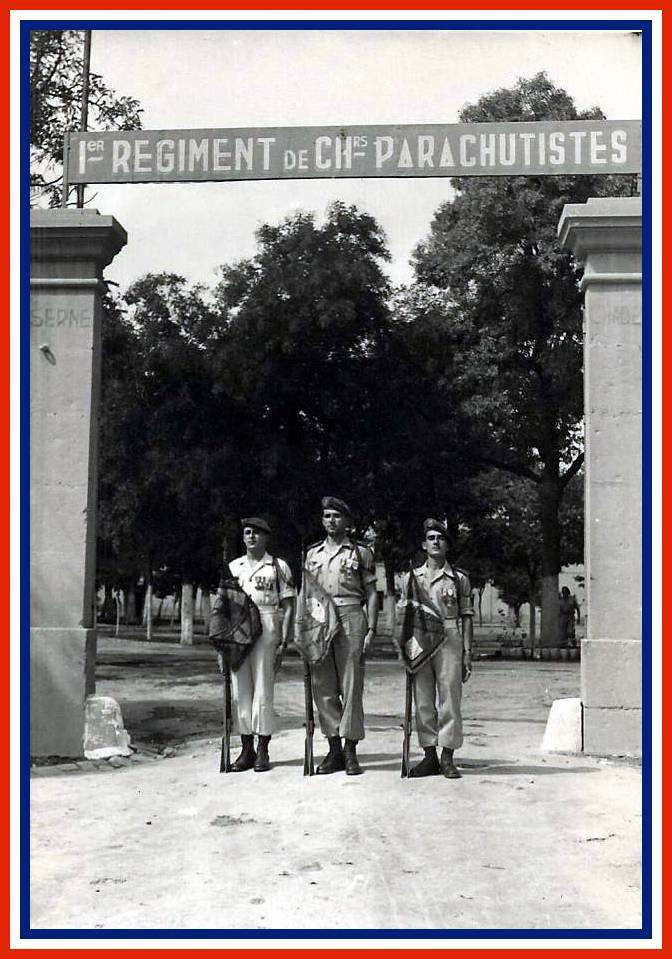
On August 27, 1949, he embarked in Marseille aboard the “Sidi-Okba”, landing the next day in Philippeville, Algeria.
In Sétif, he took command of the 3rd Battalion of the 1st RCP.
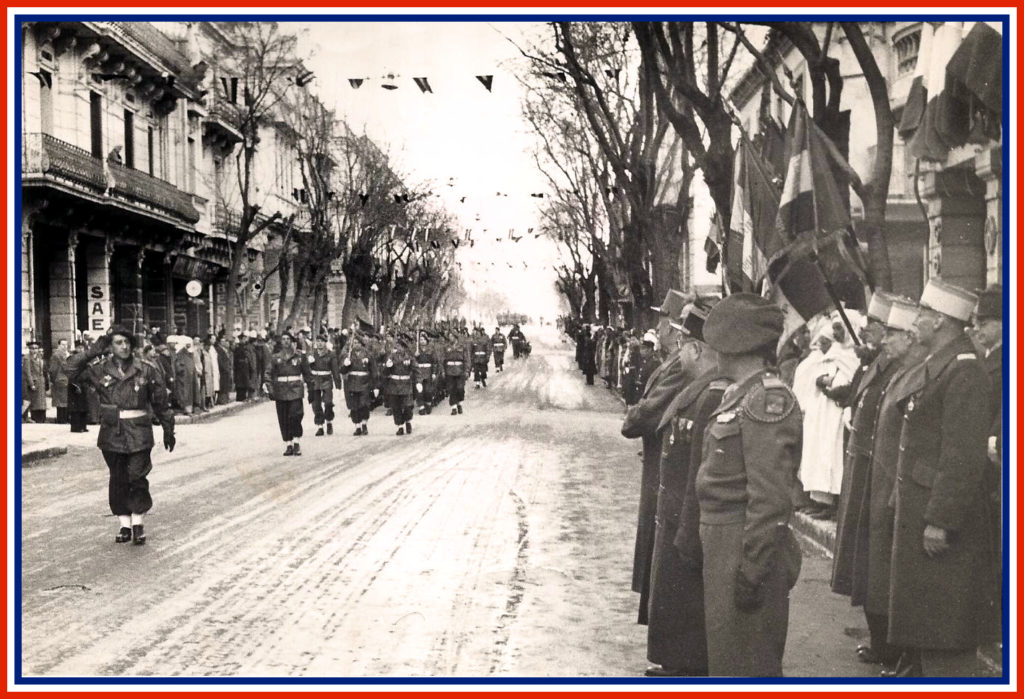
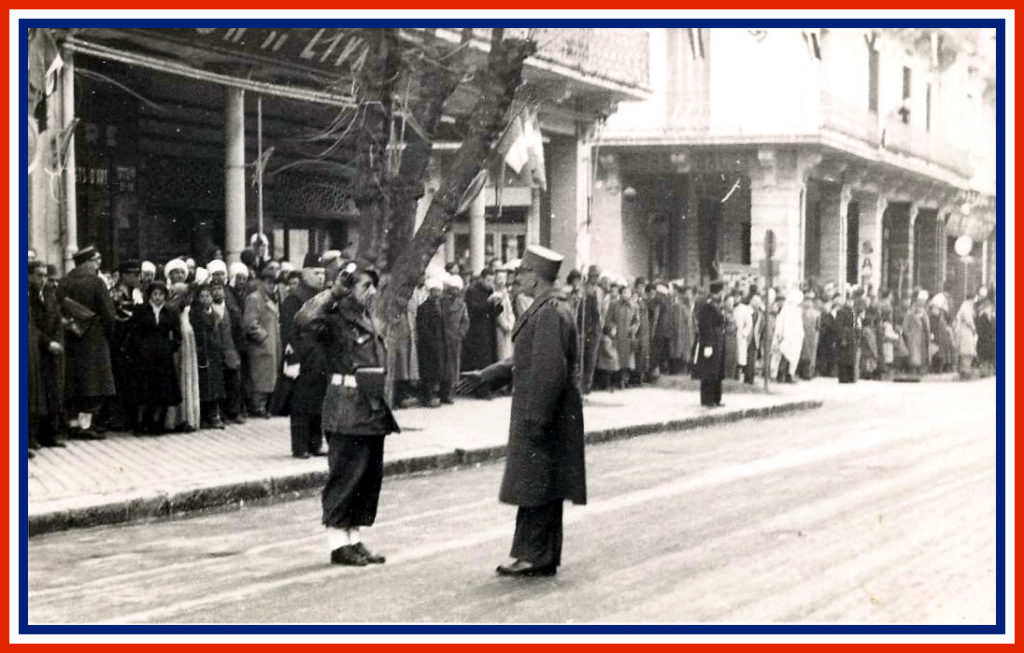
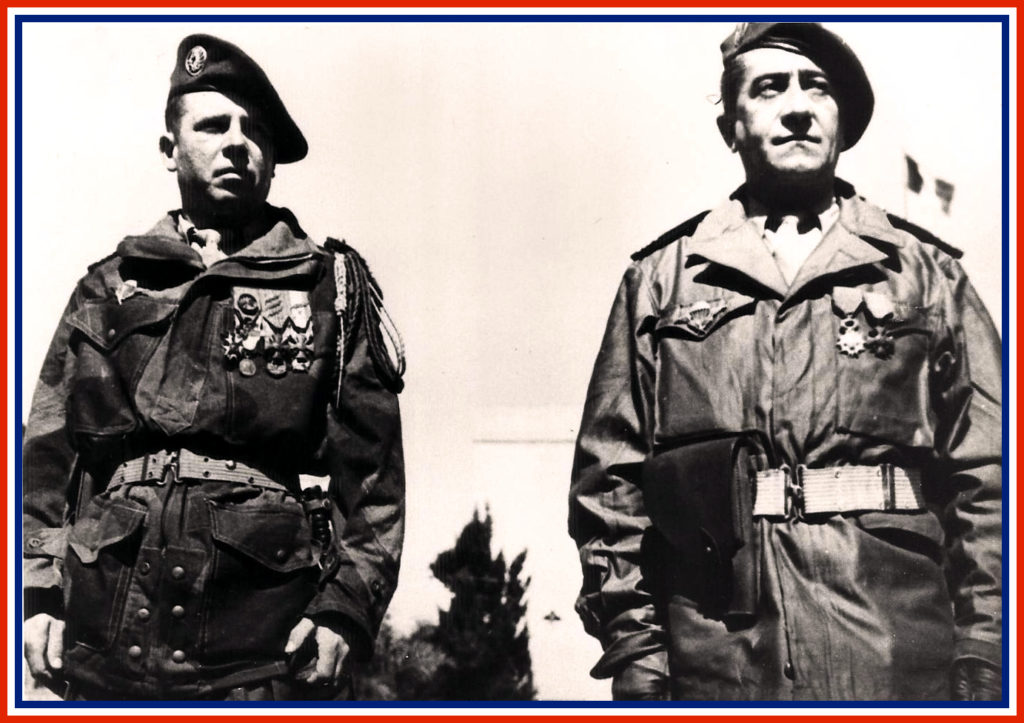
On November 3, 1951, he embarked on the ship “Djebel Dira” for metropolitan France, where he was assigned to Air Base 701 in Salon-de-Provence as director of military studies at the Ecole de l’Air.
From October 1957 to March 1960, he served in Algiers and Colomb Béchar, during which time he was twice cited:
By General Order n°122 to the Brigade Order on November 29, 1958:
“An ardent senior officer who, through his personal contacts, his drive and his enthusiasm, has rallied many Muslims to the national cause. Since his arrival at the Western Saharan zone headquarters in May 1958, he has worked tirelessly, taking advantage of his incessant tours as OLAT officer to rally the population and explain France’s action to them. He was one of the main architects of the mass support of September 28, 1958”. Croix de la Valeur Militaire with Bronze Star.
By General Order no. 144 to the Army Corps Order on July 17, 1959 :
“Senior officer seconded since May 1958 to P.C.A.D. 29/540 as Air-Land liaison officer. On October 23 and 24, 1958, he took part in a major operation in the KSOVRS mountains, marking a jumping zone and supplying troops on the ground by air, in the RHEZALA massif. In addition, on April 28, 1959, during the interception of a rebel caravan east of IGLI, played a key role in the success of the action, personally directing the airborne commando’s drop as close as possible to the objective, and then uncovering the equipment carried by the caravan. In one year, carried out one hundred operational air missions, representing 266 flight hours, a third of which were visual reconnaissance and fire support for ground troops”. This citation includes the Croix de la Valeur Militaire with vermeil star.
He was posted to the Amiens headquarters on March 5, 1960, then to the Nevers headquarters on September 1, 1961.
He left the army in 1963 with the rank of lieutenant-colonel, after 32 years of loyal service.
Returning to civilian life, he taught mathematics at Juilly College in Seine et Marne.
He died on March 2, 1975 in Toulon at the age of 64.
His décorations :
Officier de la Légion d’Honneur,
Croix de Guerre 1939-1945 avec étoile de bronze (1940) et palme(1945),
Croix de la Valeur Militaire avec étoile de Bronze (1958) et étoile de Vermeil (1959).
Croix du combattant,
Médaille commémorative 1939-1945 avec barrettes “France”, “Afrique” et “Italie”,
Médaille commémorative 1939-1945 avec agrafes “Libération” et “Allemagne”,
Médaille commémorative des opérations de sécurité et maintien de l’ordre en A.F.N. avec agrafe “Algérie”,
Our sincere thanks to Jean-Louis AUDEBERT, Jean’s son, for his invaluable help in sharing his family archives.
sources: AUDEBERT family – “Le 1er RCP tome 1” by Georges Fleury – Militaria Magasine article “Le 1er RCP dans les Vosges : “La 8 ! C’est la 8 !” by Guillaume Morelli – “1 RCP témoignages pour l’histoire” by ECPAD – “le 1 RCP à travers ses fanions 1937 – 2019” by Editions Memorabilia.
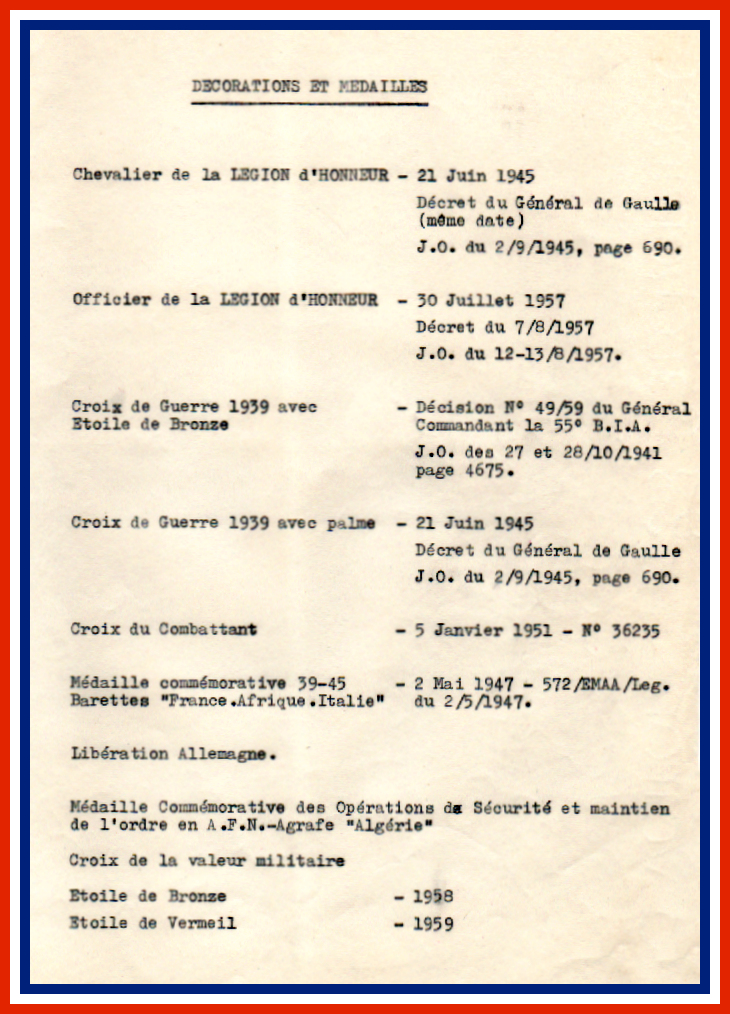
Jagdpanther ausf.G2 n°321, 3./Schwere Panzerjäger-Abteilung 654.
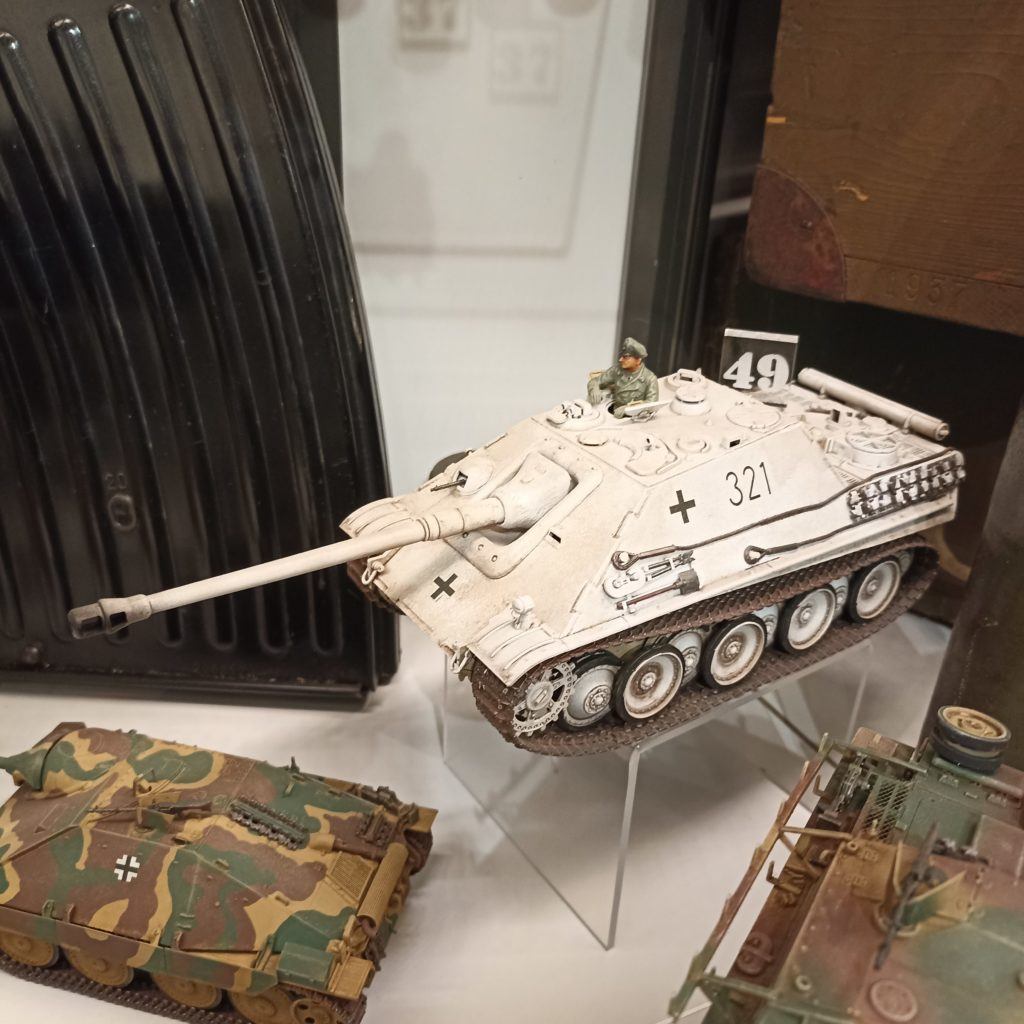
Jagdpanther ausf.G2 of Feldwebel Carstens’ 3./Schwere Panzerjäger-Abteilung 654
abandoned during the fighting at Riedwihr (68), after mortar fire damaged the engine block and immobilized the steel behemoth.
Produced in 392 examples, it is a formidable tank hunter armed with a powerful 8.8cm Pak 43/3 L/71 cannon (55 to 60 shells) and 1 MG34 machine gun (7.92mm – 3000 rounds).
It could destroy any French or American armored vehicle on the Western European front.
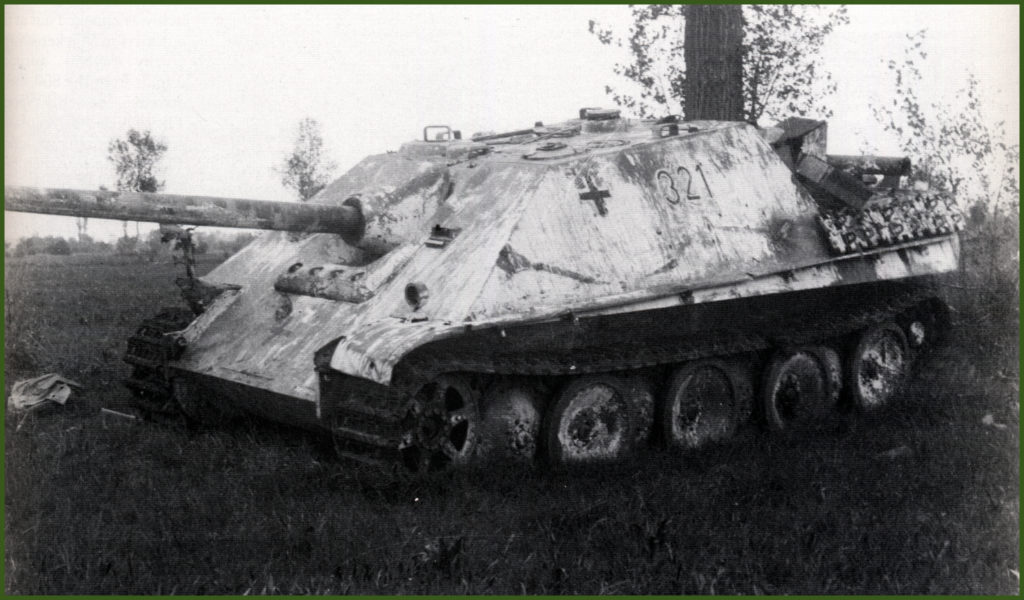
Main features:
415 produced (G1 & G2 variants).
Crew of 5 (tank commander, pilot, gunner, loader, radio operator).
Length 9.87 m (with gun) or 6.87 m (without gun).
Width 3.42m and height 2.72m.
Weight: 45.5 tonnes.
23.1-liter liquid-cooled Maybach HL230 P30 v12 engine, 690 hp (515 kW).
Sources : “The combat history of Schwere Panzer Abteilung 654 de karlheinz Münch – internet.
Jacques FAURE 1904 – 1988
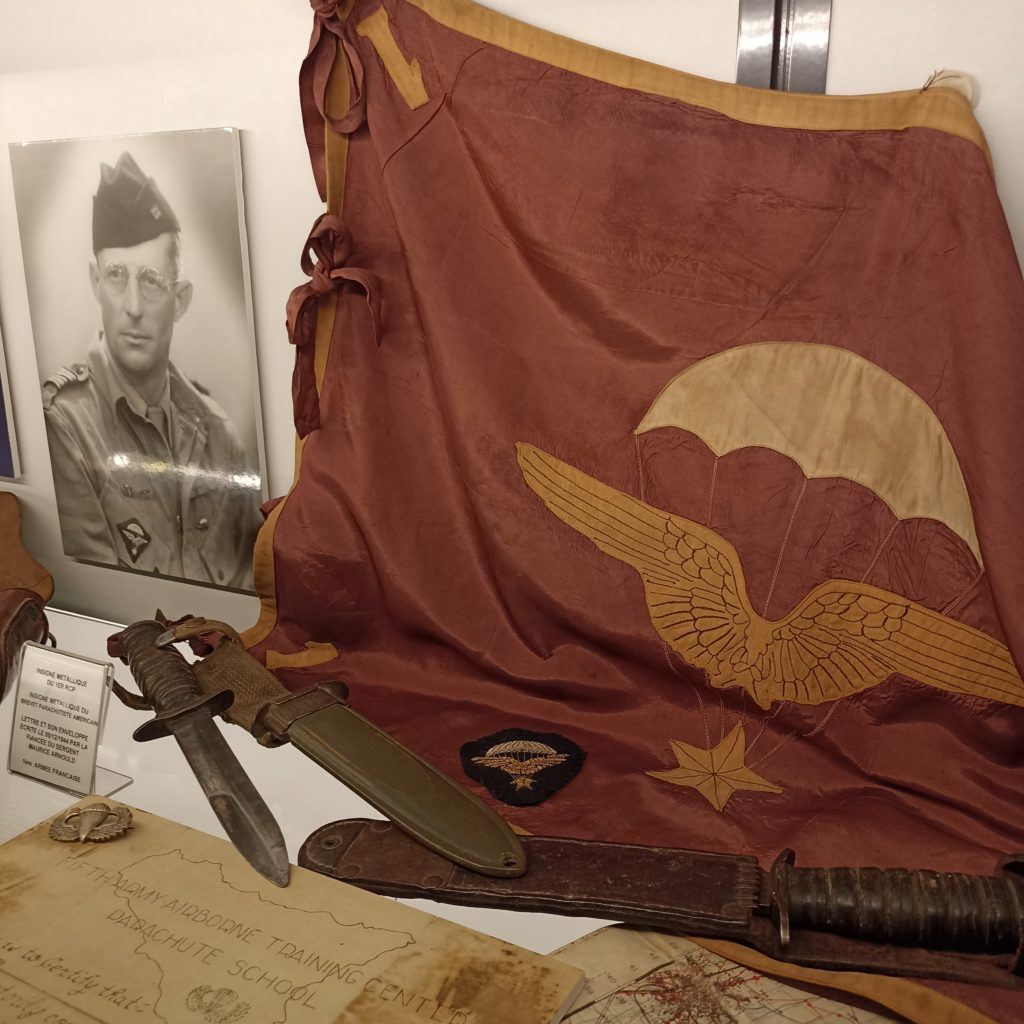
Jacques Faure was born on March 2, 1914 in Bordeaux (33).
Son of a colonel and grandson of a general, he was naturally drawn to a military career.
He entered the Ecole Spéciale Militaire de Saint-Cyr in the “Morocco and Syria” class of 1925 – 1927.
On graduating, as a young lieutenant, he was assigned to the 13th Battalion of Mountain infantrymen (October 1927).
In 1930, he was appointed head of a scout-skier section. Promoted to Captain and an excellent skier, in 1932 he was assigned to the Ecole de Haute-Montagne in Chamonix and took command of the French military ski team (until 1938).

It was during this period that he became French military champion 7 years running. He took part in the 1936 Olympic Games in Garmisch-Partenkirchen, where he had the honor of being flag-bearer for the French delegation. He finished 6th in the military patrol race.
In 1938, he was assigned to the 64th Division Staff. Under the command of General Béthouart (future commander of the 1st Army Corps of the First French Army), he was assigned to the High Mountain Brigade in early 1940, with whom he took part in the fierce fighting of the Norwegian campaign. He played an important role in the battle of Narvik with the French expeditionary corps.
On his return, during a stopover in England, he declined a proposal to join General de Gaulle’s army, and returned to France in June 1940.
General d’Harcourt asked him to set up the “jeunesse et montagne” (youth and mountains) movement, to get young air force personnel into the mountains. He then left for North Africa, to Morocco, where he headed the youth and sports department (until 1942).
He took part in preparations for the Allied landings in North Africa (November 8, 1942) and then served in General Giraud’s cabinet (until March 1943).
He was ready to return to combat with the 1er Régiment de Chasseurs Parachutistes (1 RCP – French Paratroopers), which he joined in July 1943 as assistant to Colonel Geille, who took command.
He was commissioned as a parachutist (Brevet n° 1441) on November 1, 1943 in Oudja (Morocco) at the Airborne Training Center of the 82dn Airborne US.
By the end of 1943, the 1 RCP was well trained and equipped by the Americans, and the men were in high spirits, ready to take on the German army to liberate France.
At the end of March and beginning of April, the regiment left North Africa for Sicily, then Rome at the beginning of July, before landing at Valence-Chabeuil in early September (after the Provence landings).
For Major Faure and his men, the baptism of fire began at the beginning of October 1944, during the Vosges campaign from October 2 to 22, 1944, when the breakthrough of the 1st RCP through the German defenses in the Vosges massif resounded with the names of the places (Ferdrupt – col du Morbieu – forêt du Gehan, tête du Midi – le ménil – côte 1008 – col du Ménil – côte 1111) where they fought heroically in very difficult material and climatic conditions, facing an outnumbered enemy at the cost of heavy losses: 129 killed and 339 wounded.
On November 28, 1944, Colonel Geille left the 1st RCP to join the Air Staff, and his deputy Major FAURE took command of the Regiment.
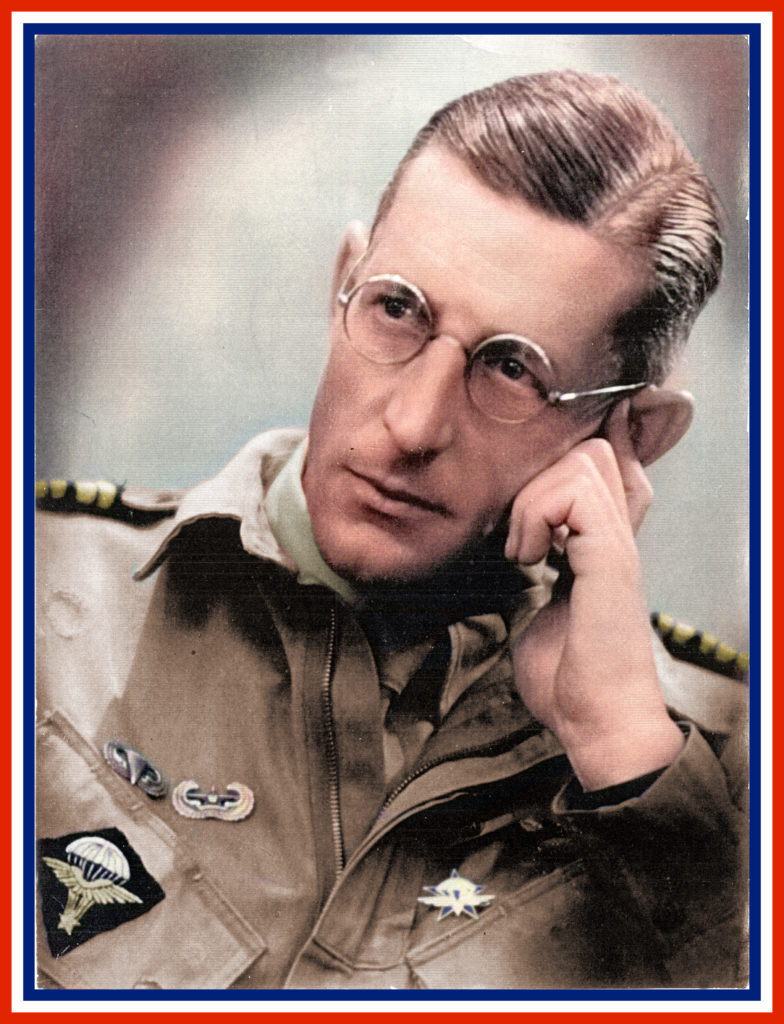
Lieutenant-Colonel Faure had the onerous task of leading the 1st RCP during the terrible Alsace campaign, from December 13 to 22, 1944, in the Witternheim(67), Neunkirch(67), Bindernheim(67), Mayhols woods, Friesenheim(67) sector…then from January 1 to 8, 1945, in the Orbey(68) sector, and for the following 2 weeks occupying the Bonhomme and Schlucht passes. Following the German counter-offensive on Strasbourg, the 2nd Battalion of the 1st RCP was rushed to Benfeld on January 9, 1945, where it fought at Herbsheim(67) and Rossfeld(67).
On January 15, 1945, the 1st RCP was placed at the disposal of Combat Command 6 of General de Vernejoul’s 5th Armored Division, and took part in the terrible fighting at Jebsheim from January 25 to 30 (76 killed and 167 wounded), and at Widensolen from January 31 to February 1, 1945 (15 killed and 45 wounded), in polar temperatures of minus 20 degrees, facing the formidable alpine hunters of the Gebirgs-Jäger-Regiment 136 of the 2.Gebirgs-Division, an elite unit of the German army. The Alsace campaign resulted in 176 killed and 512 wounded, i.e. 60% of its strength.
After the war, he was promoted to colonel in 1946 and took command of the airborne group of the 25th Airborne Division.
From 1948 to 1949, he attended the Ecle Supérieur de Guerre. Until 1952, he worked at the Institut des Hautes Etudes de la Défense Nationale and the Centre des Hautes Etudes Militaires.
Between 1952 and 1953 he was Military Governor of Vienna in Austria, then served on the Allied Land Forces Headquarters in Fontainebleau.
He was appointed Brigadier General in 1954 and took command of the Saint-Maixent infantry school.
He was promoted to Division General in 1958 and commanded the 27th Alpine Infantry Division in Kabylia (until 1960).
During the Algerian war, his son, a young lieutenant in the 27th Battalion of Alpine Chasseurs, was killed.
He left the army in 1961.
He died in Paris on April 9, 1988.
his decorations :
Commandeur de la Légion d’Honneur
Croix de Guerre 1939-1945 avec 5 palmes
Croix de la valeur Militaire avec une palme
Médaille de l’Aéronautique
Commandeur de l’ordre du mérite sportif
Croix de Guerre Norvégienne avec épée.

Henri SCHAUB 1920 – 2019

Henri was born on July 8, 1920 in WITTELSHEIM, Alsace, and was forcibly drafted into the German army along with 130,000 other Alsatians and Moselle residents, considered by the Nazis to be de facto Germans.
Unable to escape (his family would otherwise be immediately deported), he had no choice but to report for compulsory military service, made compulsory by the Germans to compensate for their heavy losses, mainly on the Russian front.
On August 7, 1943, after his training period, he was sent to the Russian front. During his first combat, he refused to fight and surrendered to the Russian soldiers along with some of his comrades.
He was then interned in the infamous Camp 188 at Tambow, 450 kilometers from Moscow, from which some 10,000 Alsatians and Moselleans would not return.
Negotiations in July 1944 between the Russian authorities and General de Gaulle’s provisional government enabled the release of the “first” 1,500 Alsatian-Moselle prisoners (unfortunately, they were also the last), including Henri SCHAUB.
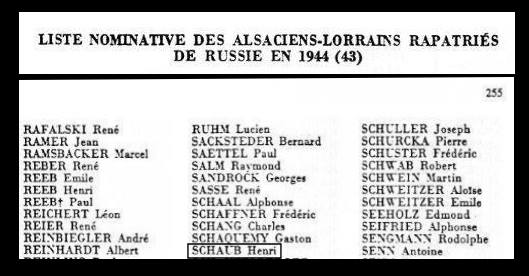
On July 7, 1944, Henri left Camp 188 for a long journey that took him through Iran (arriving in Teheran on July 18), Iraq (Baghdad on July 28), the port of Haifa (where he stayed from 1 to 17/8) in Palestine, along the Egyptian coast, then Taranto (from 23 to 27/8), arriving finally in Algiers on August 29, 1944 after having covered some 1,000 kilometers.

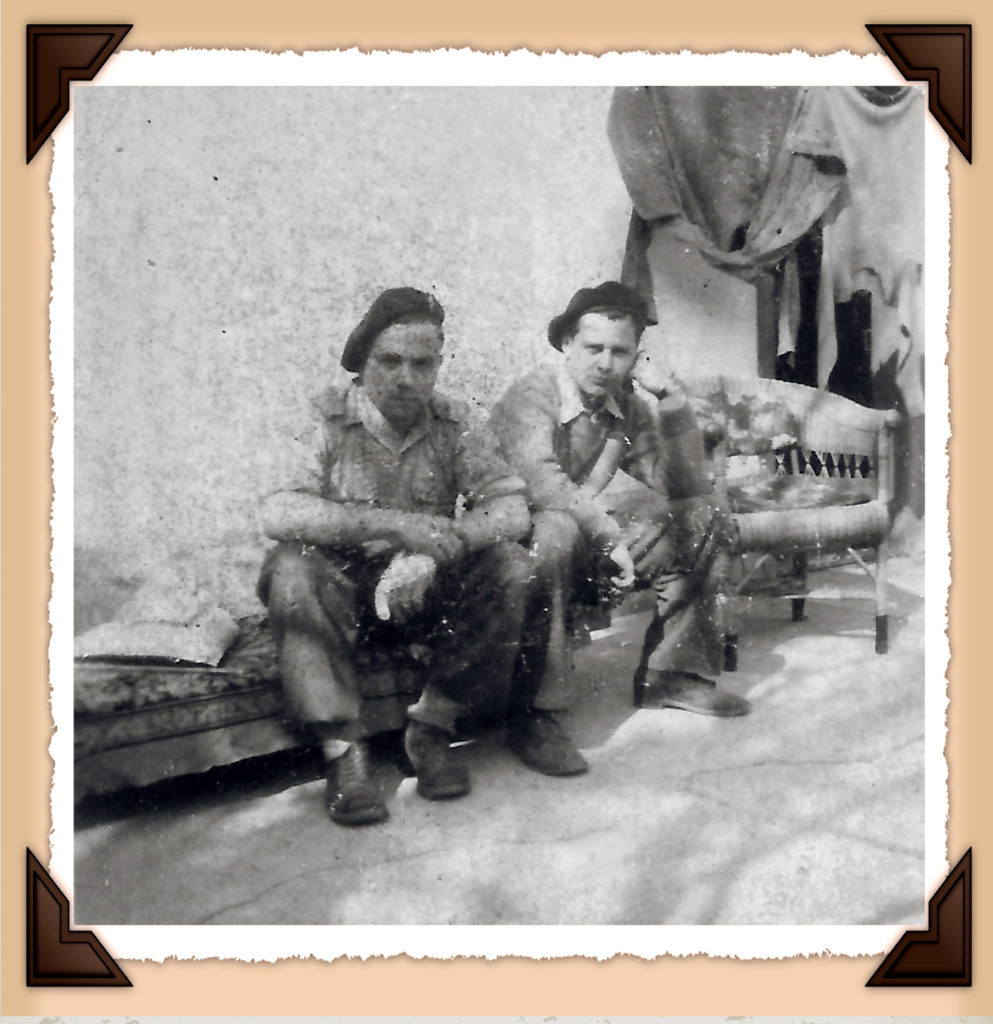
In Staouéli, in the western suburbs of Algiers, where the Groupe des Commandos de France has just been created, Henri joins.
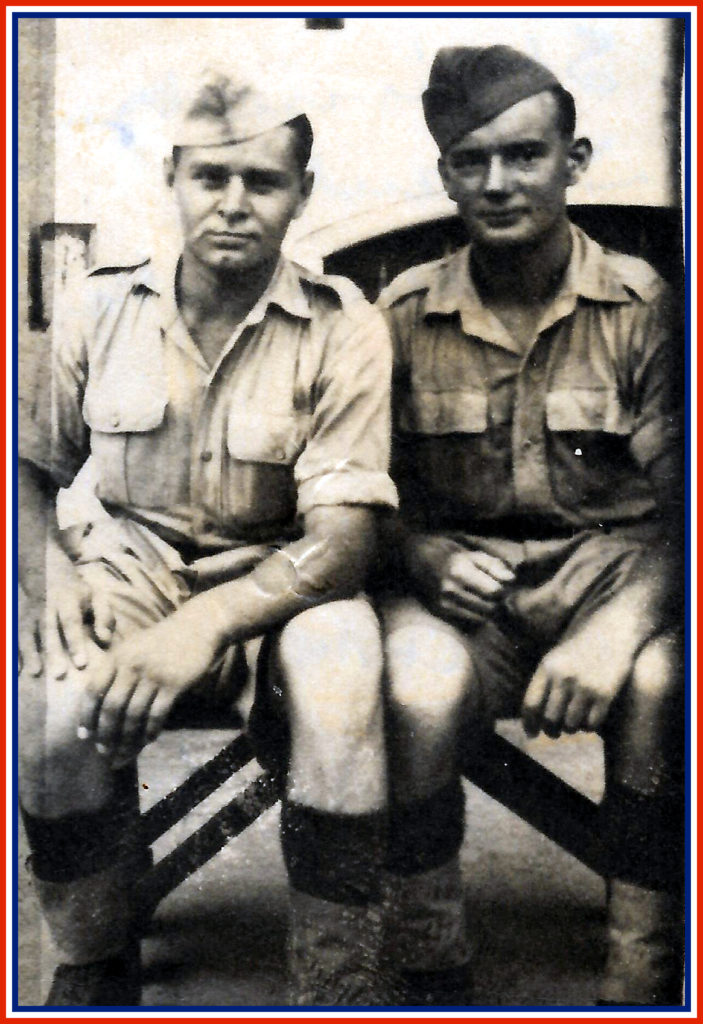
He wanted to fight the Nazis to liberate France and his native Alsace from the invaders.
He is transferred to the 3rd Commando commanded by Captain BOSMELET.
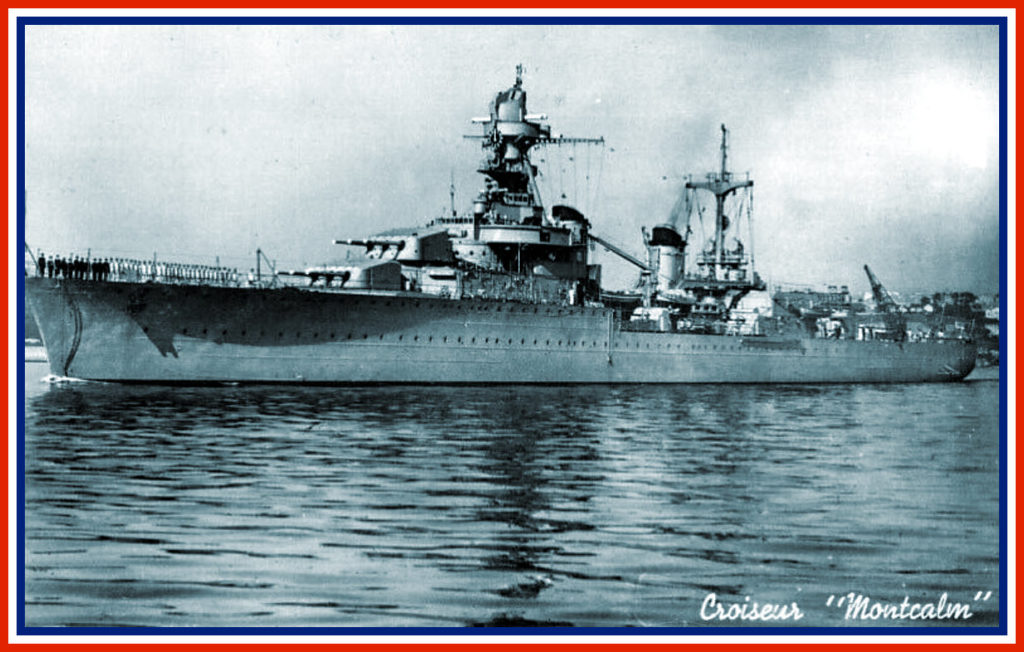
On October 9, 1944, the Commandos de France group boarded the cruiser “MONTCALM” in the port of ALGER to finally head for France.
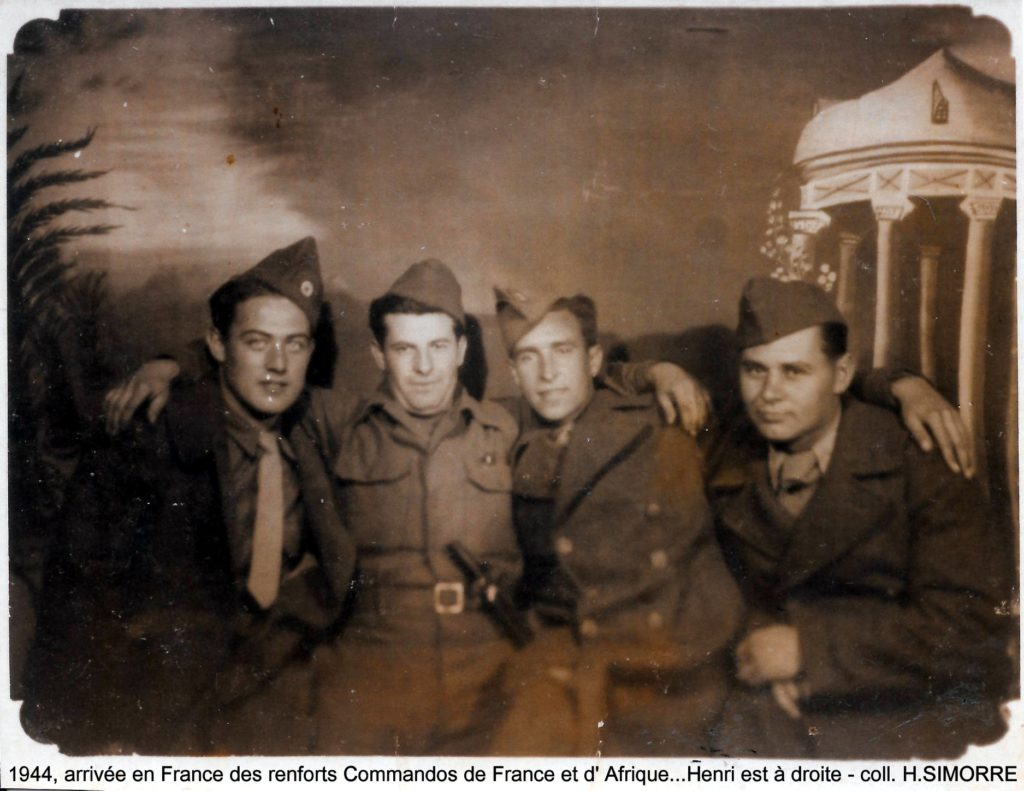
Henri Schaub’s baptism of fire came in the Vosges (Haut du Tôt), followed by Essert and the liberation of Belfort.
The Alsace campaign began for him at Masevaux, followed by the Col du Hundsrück, and the difficult liberation battles of Thann, Durrenentzen and Soultzmatt.
On April 3, 1945, he began the German campaign…
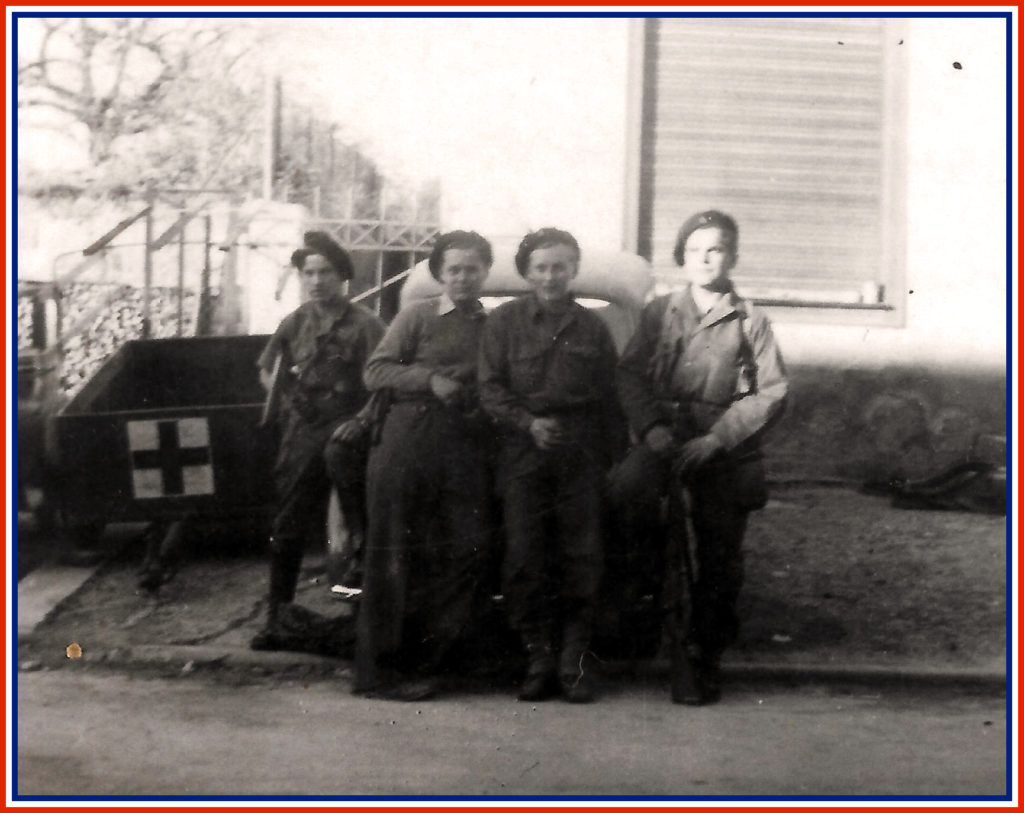
…which ended in Austria: a long way to go, but unfortunately with the loss of many brave and dear comrades…whom he will never forget.

On May 7, 1945, Henri Schaub and a few comrades from the 3rd Commando, under the command of Captain SOBRA, flew the flag of the Commando de France at the summit of the Arlberg at an altitude of 1793 meters.
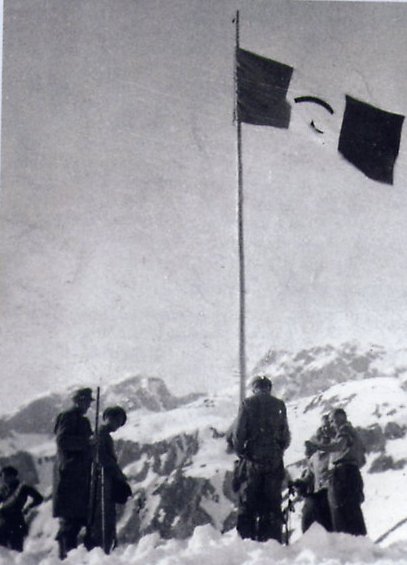
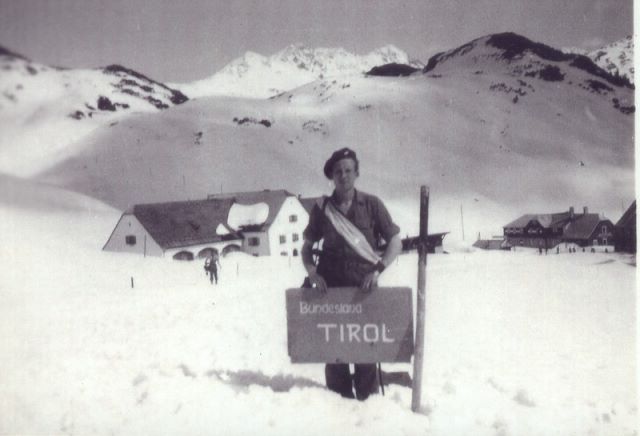
Henri was demobilized from the army on January 29, 1946.
After the war, he worked as a cook and made a career in the catering industry.
Until his last days, he attended all the commemorations in Masevaux, Durrenentzen and Soultzmatt in particular.
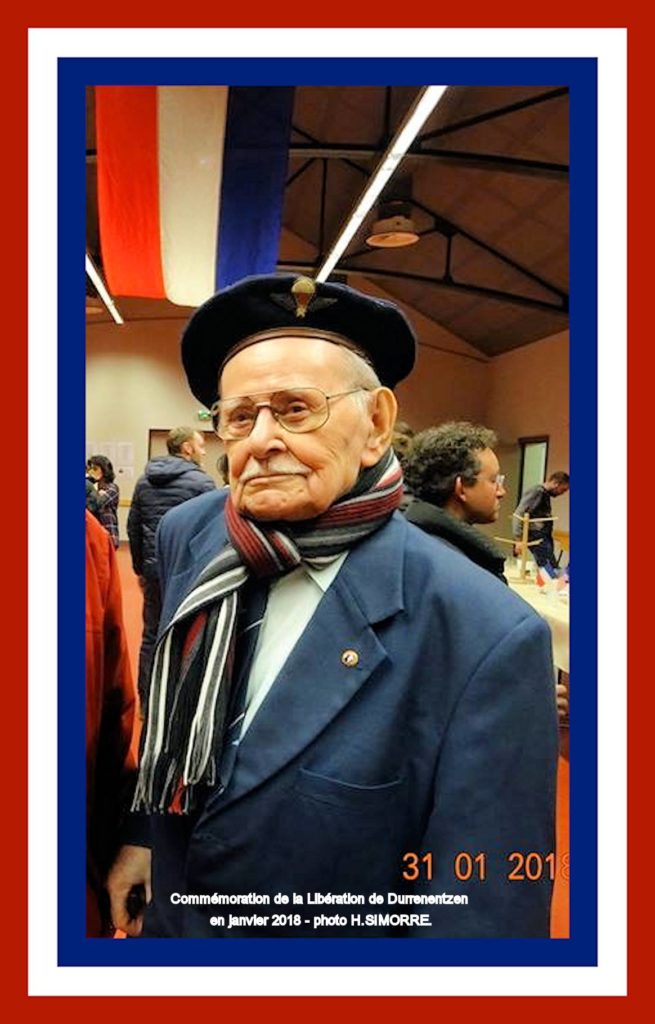
Henri SCHAUB passed away on February 21, 2019 at the age of 99.

We won’t forget!
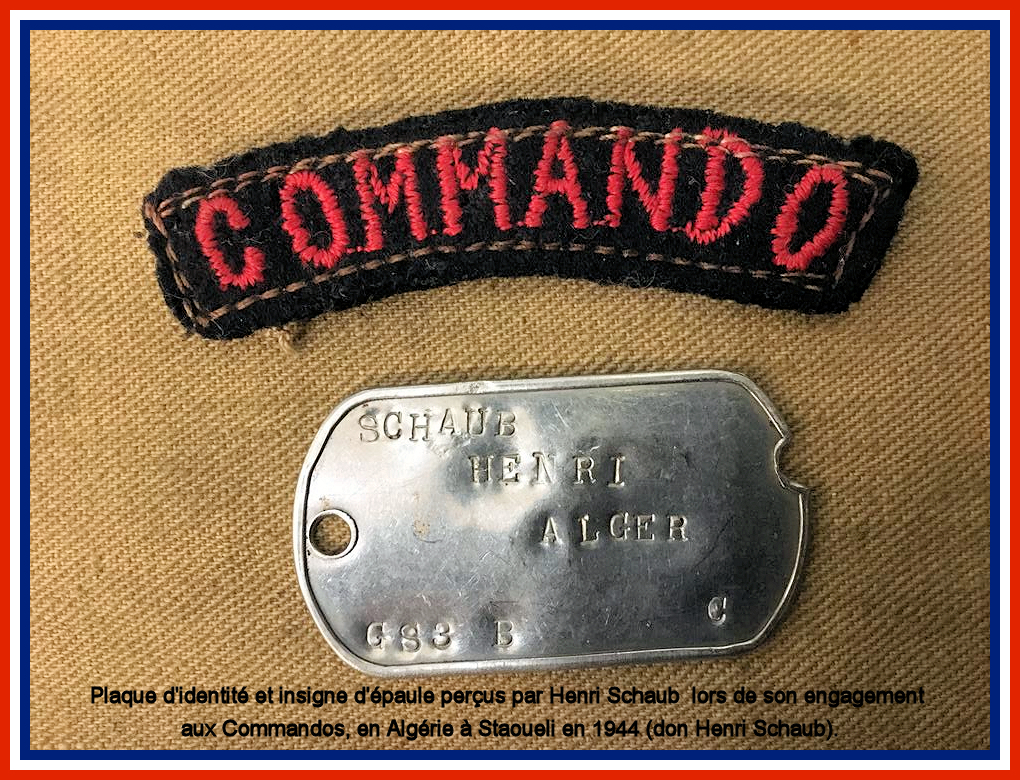
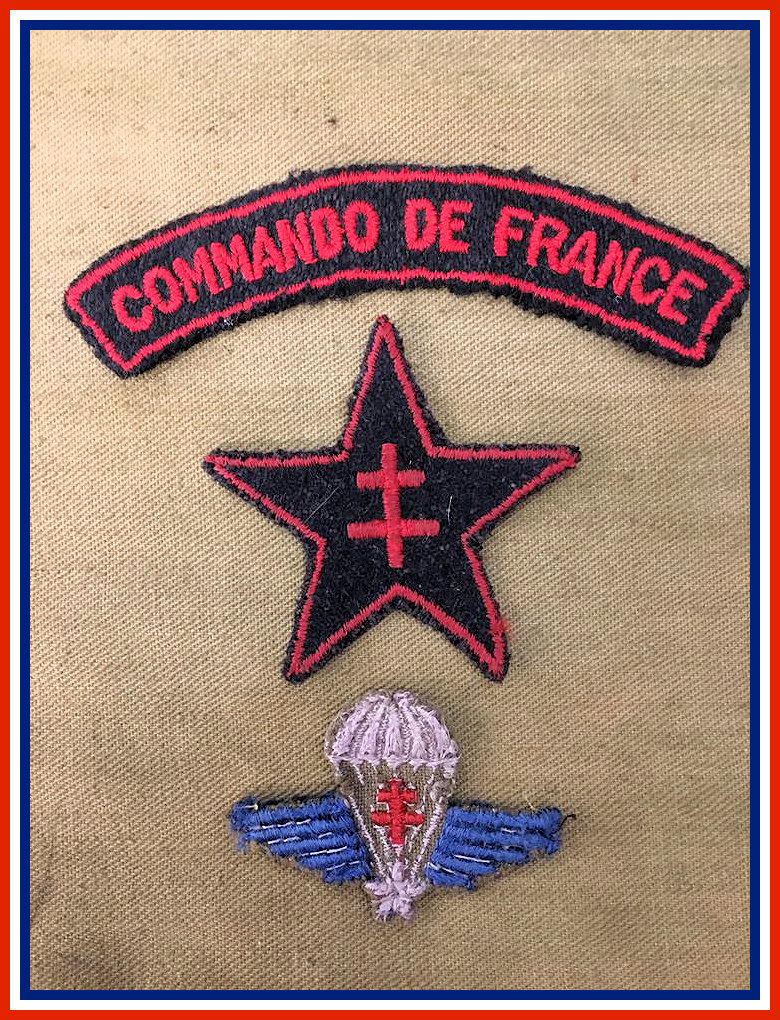
We would like to thank Henri Simorre, a specialist in the Bataillon de Choc, for the information and photos he provided for this portrait.
If you are interested in the history of the Bataillon de Choc : https://1erbataillondechoc.forumactif.com/
Guy SCHLESSER 1896 – 1970
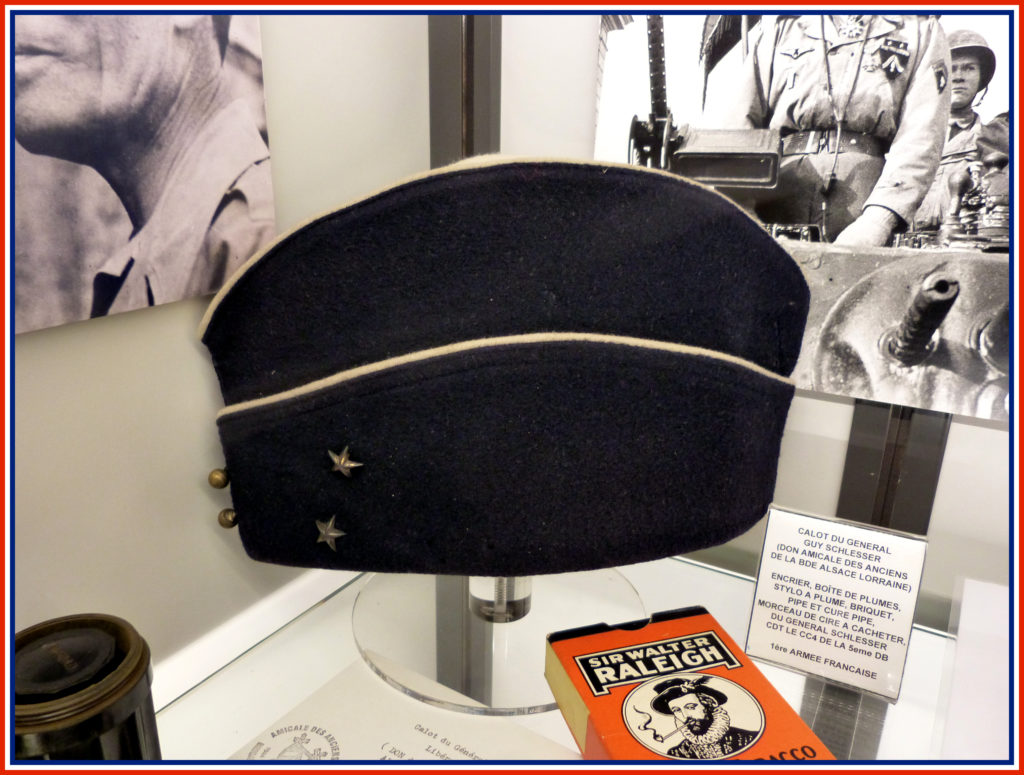
Guy Schlesser was born on March 15, 1896 in Neuilly-sur-Seine.
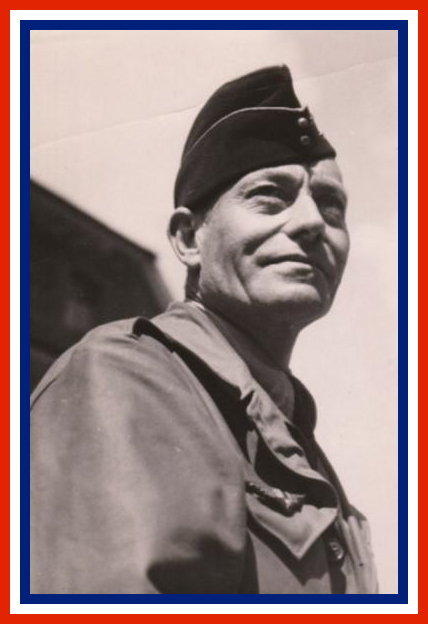
Voluntary enlisted at the Ecole Spéciale Militaire, joined the 95th Infantry Regiment (RI) on 11/08/1914.
Appointed corporal on 01/11/1914.
Temporarily promoted to Second-Lieutenant in the 134th RI on 5/12/1914.
Assigned to the 238th RI on 03/01/1915.
Permanently promoted to Second-Lieutenant on 12/27/1915 and temporarily promoted to Lieutenant on 05/02/1916.
Assigned to the 305th RI on 01/07/1916.
Permanently promoted to Lieutenant on 12/31/1916.
Seconded to escadrille 277 as an observer on 10/12/1917.
Promoted to Captain on 12/25/1918.
Officer cadet at the école spéciale militaire on 20/02/1919 and officer cadet at the école d’application de cavalerie on 15/10/1919.
He embarked at Toulon on 09/07/1920 and disembarked at Beirut on 09/08/1920, where he was assigned to the 5th Régiment de Chasseurs d’Afrique (5th RCA) on 10/08/1920.
He joined the 11th Spahis regiment on 01/01/1921.
He embarked in Beirut on 03/22/1921 and disembarked in Marseille on 03/31/1922.
He joined the 17th régiment de chasseurs à cheval on May 23/1922.
Assigned to the 31st dragoon regiment on 04/10/1923.
He was appointed riding instructor at the infantry and tank school from 10/25/1925.
Seconded to attend the war school on 01/11/1929.
Trainee at the General Staff, 2nd office, intelligence section (EMA2/SR) on 01/11/1931.
Squadron leader on 06/25/1932 and appointed to the EMA2/SR on 11/01/1933.
Assigned to the 11th cuirassiers regiment as commander of the 1st squadron group on 04/26/1934.
Joined the army staff, 2nd office, intelligence section on 06/06/1936.
Promoted to Lieutenant-Colonel on 12/25/1938 at the age of 46.
Assigned to the 31st dragoon regiment by notice dated 6/6/1940, and joined the staff of the 7th Light Mechanical Division (7th DLM) on 11/06/1940.
Taken prisoner of war on 06/17/1940.
Escaped at Saulieu, Côte d’Or on 12/07/1940.
Commanded the 18th chasseur regiment on 07/08/1940, then the 2nd dragoon regiment on 01/09/1940.
Promoted to Colonel on 03/25/1941.
Demobilized, on renewable leave and placed on armistice leave on 11/29/1942.
Escaped from France via Spain and interned on 04/01/1943; smuggled by plane to Gibraltar and landed in Algiers on 05/03/1943.
Commander of the 9th African Tank Detroyer Regiment (9ème RCA) on 03/26/1943.
He embarked at Oran in Algeria on 09/16/1944 and landed at Marseille on 09/19/1944.
Promoted to Brigadier General on 11/25/1944.
He distinguished himself at Autun, then in the liberation of Belfort and Colmar.
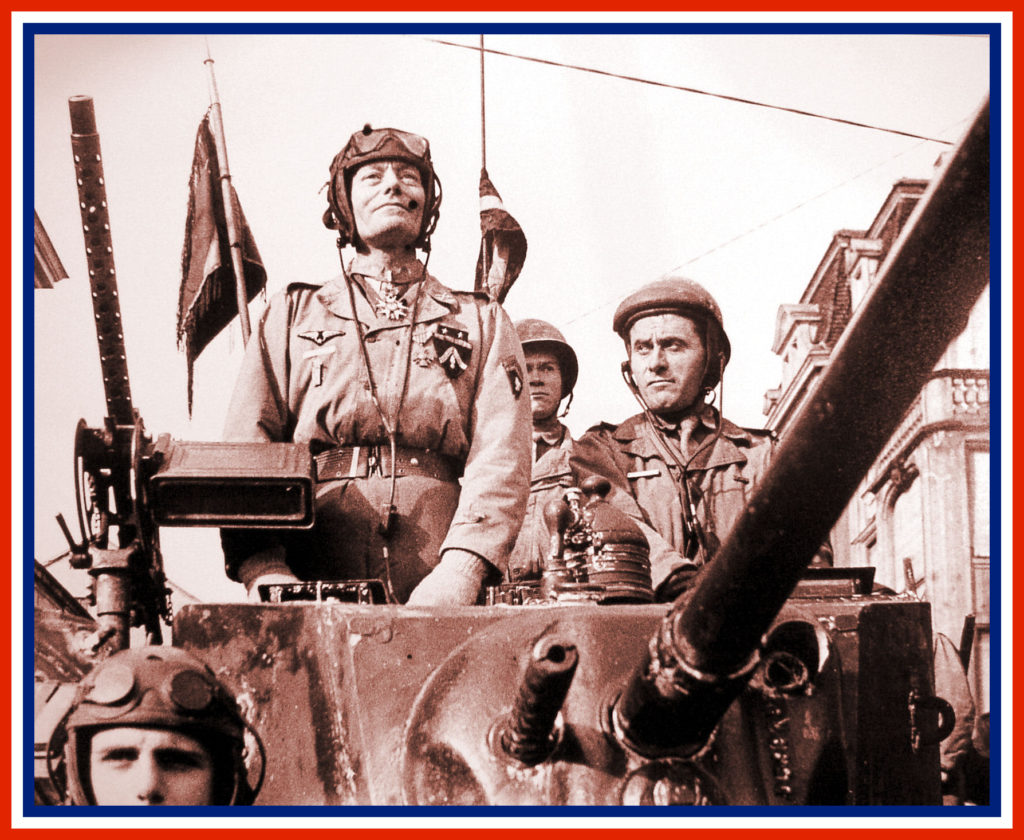
Commander of the 5th French Armored Division on April 21/1945.
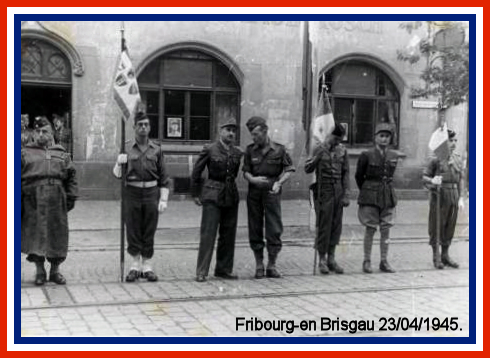
Commanded the Coëtquidan inter-army school on 08/03/1946.
Commander of the Algiers Territorial Division on 06/01/1947.
Commander of the 5th French Armored Division on 01/31/1949.
Promoted to Major General on 01/02/1949.
Deputy to the General in command of occupation troops in Germany from 05/31/1950.
Chief of Staff to the Minister of National Defense on 27/07/1950.
Commanded the 1st Army Corps and the southern territorial zone of French forces in Germany on 01/11/1951.
Promoted to Lieutenant General on 04/23/1952.
At the disposal of the Minister of National Defense and Armed Forces, in charge of the organization of forces on 14/10/1954.
Reached the age limit for his rank, placed in the reserve section on 15/03/1956.
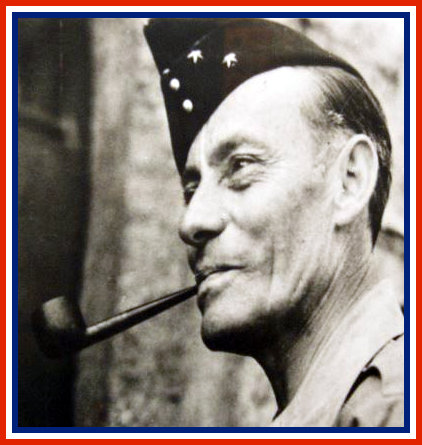
CAMPAIGNS :
Contre l’Allemagne, intérieur : 11/08/1914 au 02/01/1915.
Contre l’Allemagne, aux armées : 03/01/1915 au 19/02/1919.
Levant : 10/08/1920 au 21/03/1922.
Contre l’Allemagne, aux armées : 02/09/1939 au 16/06/1940.
Captivité : 17/06/1940 au 12/07/1940.
France sur pied de guerre : 13/07/1940 au 03/01/1943.
En Espagne, interné : 04/01/1943 au 04/03/1943.
En Algérie : 06 au 07/03/1943.
En Tunisie 08 au 25/03/1943.
Au Maroc : 05/06/1943 au 10/04/1944.
En Algérie : 11/04/1944 au 15/09/1944.
France aux armées : 20/09/1944 au 08/05/1945.
Allemagne, occupation : 09/05/1945 au 08/03/1946.
En Algérie 04/01/1947 au 26/01/1949.
Allemagne, occupation : 31/01/1949 au 19/07/1950.
Allemagne, occupation : 01/11/1951 au 14/03/1956.
CITATIONS and AWARDS :
Citation in the order of the 63rd Infantry Division, General Order no. 114 of 06/23/1916:
“On 07/06/1916, showed exemplary bravery and tenacity in leading his company, under heavy barrage.”
Citation to the % of the 2nd Army, April 1917:
“Officer of remarkable courage, on 13/03/1917 showed a disregard for danger that powerfully stimulated the momentum of a wave of assault.”
Citation to the 63rd Infantry Division, General Order n°195 of 09/20/1917:
“Young, energetic officer, commanding a company and setting an example of courage and drive to his men. Leads dangerous patrols himself. Wounded on 18/08 while supervising attack work in front of our front lines. Already twice cited.
Citation in the 2nd Army Order OG n°1370 of 13/10/1918:
“Observer at escadrille 277. Elite officer, after distinguishing himself in command of an infantry company, quickly became a remarkable observer. Distinguished himself during the Woevre attacks (Lorraine) by flying over enemy lines at 50 meters, despite heavy machine-gun fire (3 previous citations).”
Citation in the Army Order, May 1940:
“High-ranking senior officer who, entrusted by the army staff with an important mission in Belgium just as the German offensive was getting underway, remained continuously in the advanced zone of operations to keep research units still in contact with the enemy on their toes. Directed the methodical withdrawal of these units, bombarded and threatened at every moment to be cut off from their axis of retreat, giving everyone a magnificent example of willpower, calm and bravery. Ceased its mission only after its energetic intervention had put out of action numerous enemy agents whose activity was threatening the security of the armies of the North”.
Citation to the CA general order n°80 of 26/07/1940:
“Assigned to the 7th DLM, which he joined on 11/06/1940 at Thibie during operations. Since his arrival at the large unit, he has constantly demonstrated the finest qualities of energy and initiative, repeatedly offering to liaise with units of the division engaged in enemy fire. During one of these liaisons, on 16/06/1940 at Saulieu, took part with the division’s rear guard in a heroic tank battle, during which he was wounded and taken prisoner. Thanks to his ingenuity and complete disregard for danger, he was able to rejoin the division after a long trek through enemy-occupied territory.
Citation to the % de l’Armé, decision n°541 of 21/03/1945 JO of 22/04/1945:
“During the battle of Orbey, from 15 to 27/12/1944, exercised with remarkable mastery the command of an important grouping of all weapons. Communicating his ardent offensive spirit to all, and setting an example, he crossed the Hâchimette valley by surprise, then seized hard-fought mountain positions, destroying reinforcements thrown by the enemy in front of his group as they arrived. Through his personal actions, was one of the main factors in the successes achieved.
Collective citation in the Army Order, decision n°384 JO of 7/12/1945 5th DB :
“A great armored unit which, under the energetic leadership of General de Vernejoul , was intimately involved in all the actions and successes of the 2nd Corps. As soon as it emerged from the Haguenau forest and during the breakthrough of the Siegfried line, CC6, under the command of Colonel de La Villéon, closely supported the 3rd DIA. Disputing priority to infantrymen at the Rhine crossing points, the C, under General Schlsesser, and the CC5, under Colonel Mozat, supported and trained the 2ndDIM and the 3rd DIA. The former wrested Pforzheim from the enemy, while the latter reached the Neckar. CC6 then took bold action, forming a bridgehead south of the Enz and forcing the enemy to concentrate their efforts in front of the gateway to Stuttgart. Combining its action with that of the 2nd Infantry Division in the heart of the Black Forest, CC4 wedged its way into the bitterly defended positions of the 357th Division. Through the breach thus opened, and followed by CC5 rushing south to the Freudenstadt outlets, CC4 exploited Calw, Nagold and Horb in a single thrust. The entire 5èmeDB, in the hands of its leader, was then decoupled to the east. Working steadily for 60 hours, it captured Tubingen and Reutligen with CC5, and on the evening of 4/27/1945, taking Stuttgart from the rear, it entered with CC4 and CC6, which immediately began clearing the city. CC6, pointing south, reached Siegmaringen, opening up the Danube route from the north. Then, with all its resources at its disposal, the 5èmeDB, under the ardent impetus of General Schlesser, raced towards the Austrian border, reaching it first on 29/04/1945. Boldly continuing its advance, clearing the shores of Lake Constance in the process, it crossed and overran the Alberg on May 7/1945. This magnificent raid completed the disorganization of the enemy, having taken 12,000 prisoners and a large amount of war material. The 5èmeDB showed itself to be faithful to the oldest traditions of French cavalry.”
Medal for escapees – commendation in the Army Order, decree of 12/02/1948 JO of 14/03/1948 :
“Magnificent trainer of men, with invincible courage and proven audacity. Captured on 17/06/1940 by the enemy, after a heroic defense, escaped 2 days later. Recaptured, escaped again and, after many difficulties, managed to rejoin his division. Refusing to accept defeat, he devoted himself without hesitation to the noble task of awakening confidence and hope, enthusiasm and faith in his men. Instilling his magnificent spirit of self-sacrifice, he succeeded in forging in the shadows, with the 2nd dragoon regiment he commanded, an elite weapon in the service of victory. At the time of the invasion of the unoccupied zone in November 1942, organized and carried out the rallying of his formation to the fighting French forces. Escaped from France via Spain in January 1943, only to see his unit rally around its glorious standard in AFN 10 months later.
BLESSURES :
INJURIES :
On 18/08/1917 at Mort-Homme (on the left bank of the Meuse, northwest of Verdun) by shrapnel.
On 06/17/1940 in the Saulieu battle (37 French servicemen and 11 civilians were killed) by shrapnel.
Décorations :
Chevalier de la Légion d’Honneur (26/12/1918)
Officier de la Légion d’Honneur (01/01/1940)
Commandeur de la Légion d’Honneur (03/04/1945)
Grand Officier de la Légion d’Honneur (27/10/1948)
Croix de Guerre 1914-1918
Croix de Guerre 1939-1945
Médaille de la Résistance française avec rosette (24/4/1946)
Médaille des évadés (12/02/1948)
Croix du Combattant volontaire (27/07/1936)
Croix du combattant 1914-1918
Médaille de la Victoire
Médaille commémorative 1914-1918
Grand officier du Ouissam Alaouite (17/01/1946)
Commandeur du Nicham Iftikhar(28/01/1935)
Officier de la Polonia Restitute
Officier du Lion blanc
Distinguished Service Cross
Officier de la Legion of Merit
Bronze Star Medal
Commandeur de l’Etoile noire (03/01/1952).
Lieutenant General Guy Schlesser died on February 14, 1970 and is buried in the Ladhof communal cemetery in Colmar.
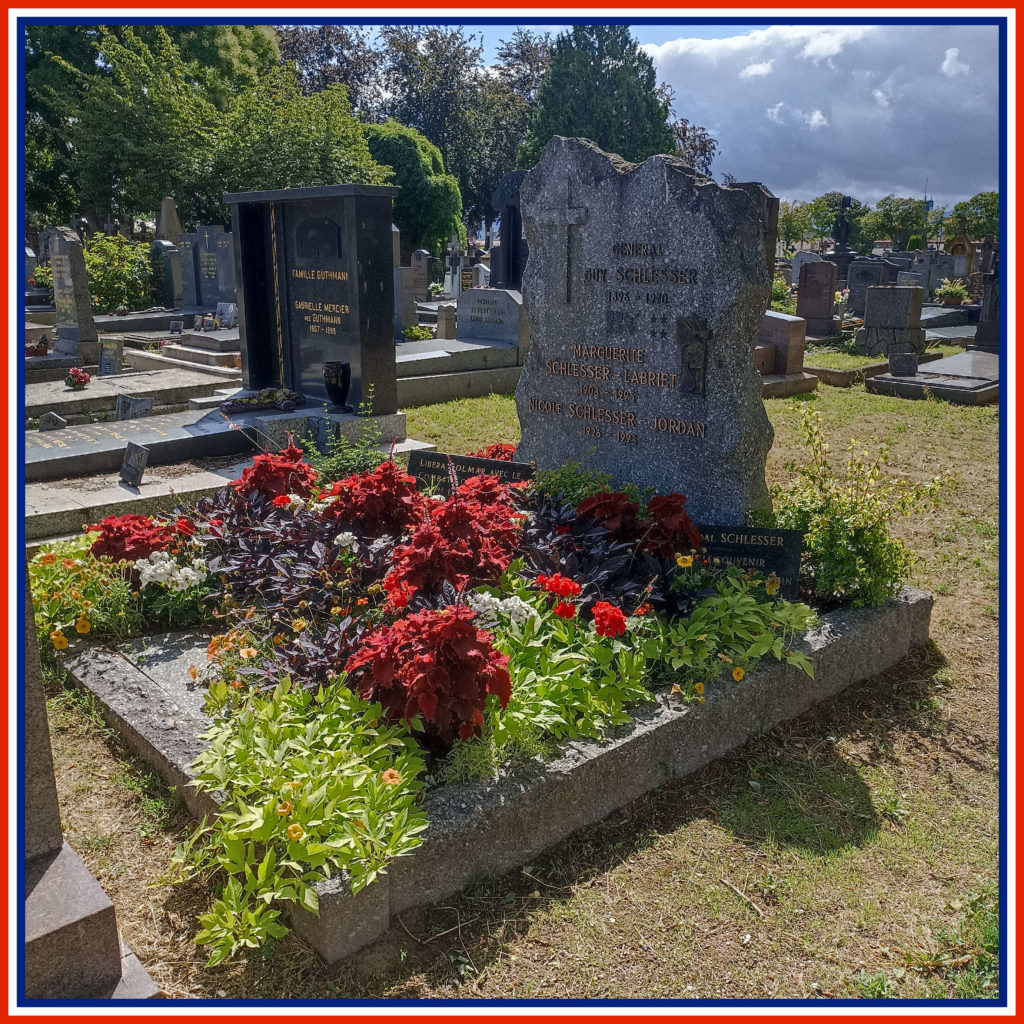
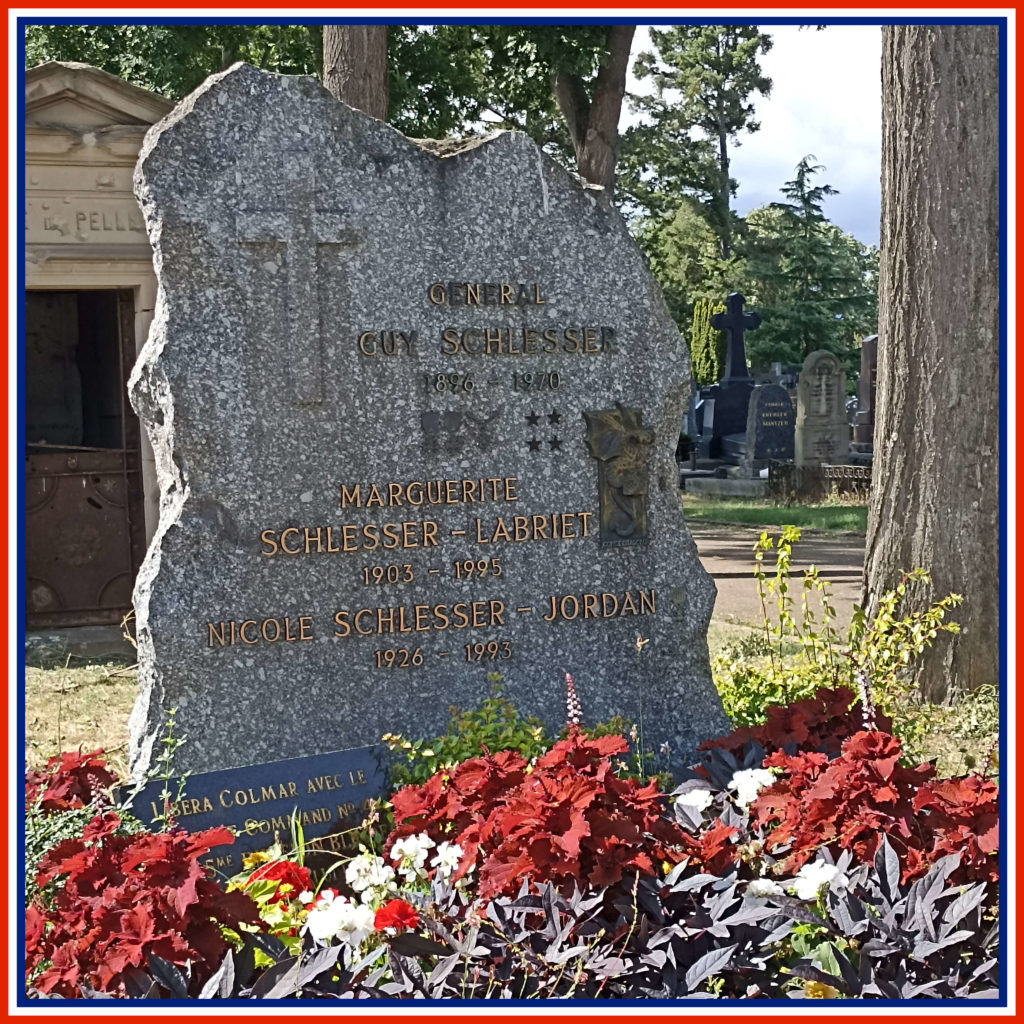
Goumier of the 2nd Group of Moroccan Tabors (2ème G.T.M.).
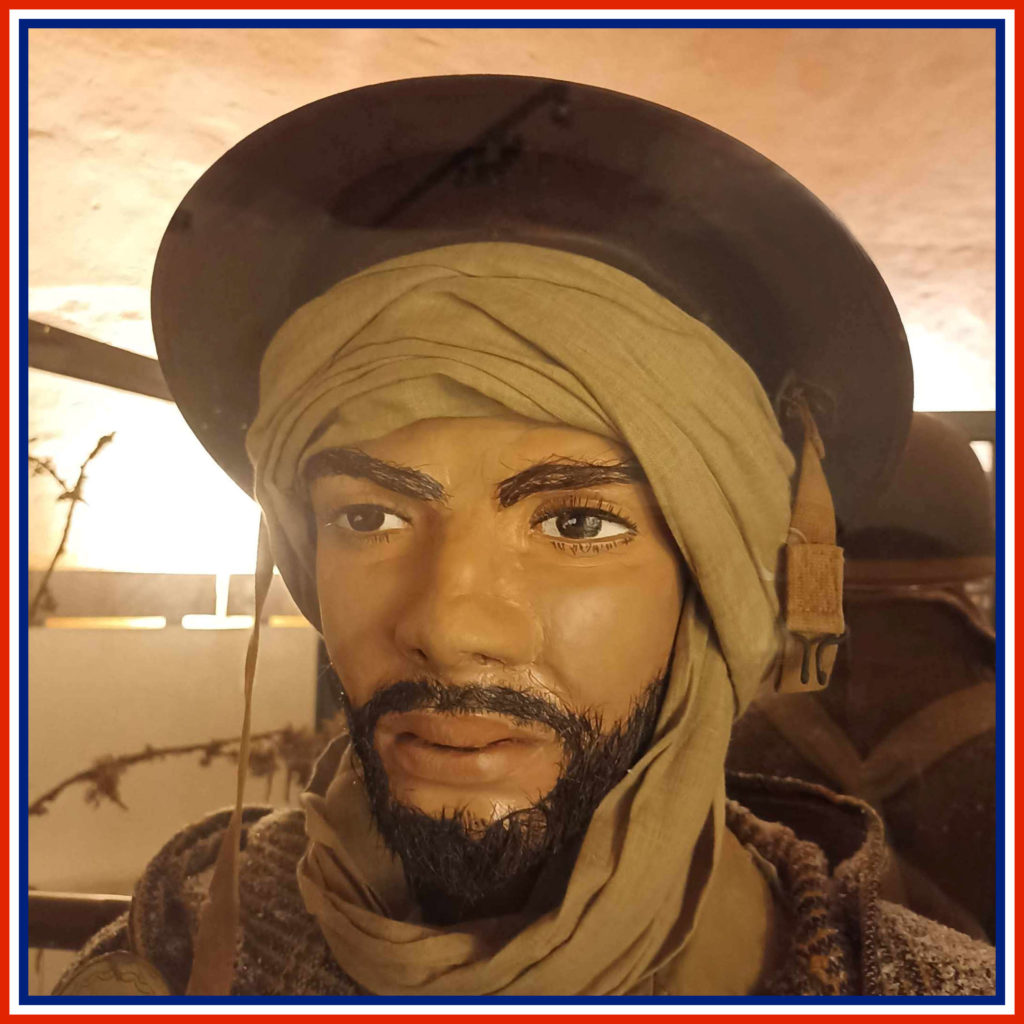
From December 7 to 17, 1944, the 2nd GTM was attached to the 36th DIUS in order to seize Orbey (68) and infiltrate further east towards Trois-Epis, a natural ledge of the Vosges mountains with an unobstructed view over the Alsace plain.
On December 7, 1944, the 6th Tabor captured Hachimette(68) and attempted to take Lapoutroie(68), but was violently repulsed by German troops. The following day, the attack on Lapoutroie was successfully resumed, and the 73rd Goum immediately attacked the Grand Faudé (773 meters), which dominates the surrounding valleys, taking control of the summit and its tower. On December 9, the 1st Tabor, reinforced by armored vehicles, tried to open up a route to Orbey (68)…the fight was fierce and after 3 days of uninterrupted fighting in the cold and snow, the goumiers were showing signs of fatigue. In addition, evacuations for frozen feet were becoming increasingly frequent. On December 10, the Goumiers positioned at Grand Faudé repel a ninth German counter-attack. In the days that followed, the 2nd GTM suffered numerous losses as a result of relentless German attacks to dislodge the goumiers from the strategic positions they were heroically holding.
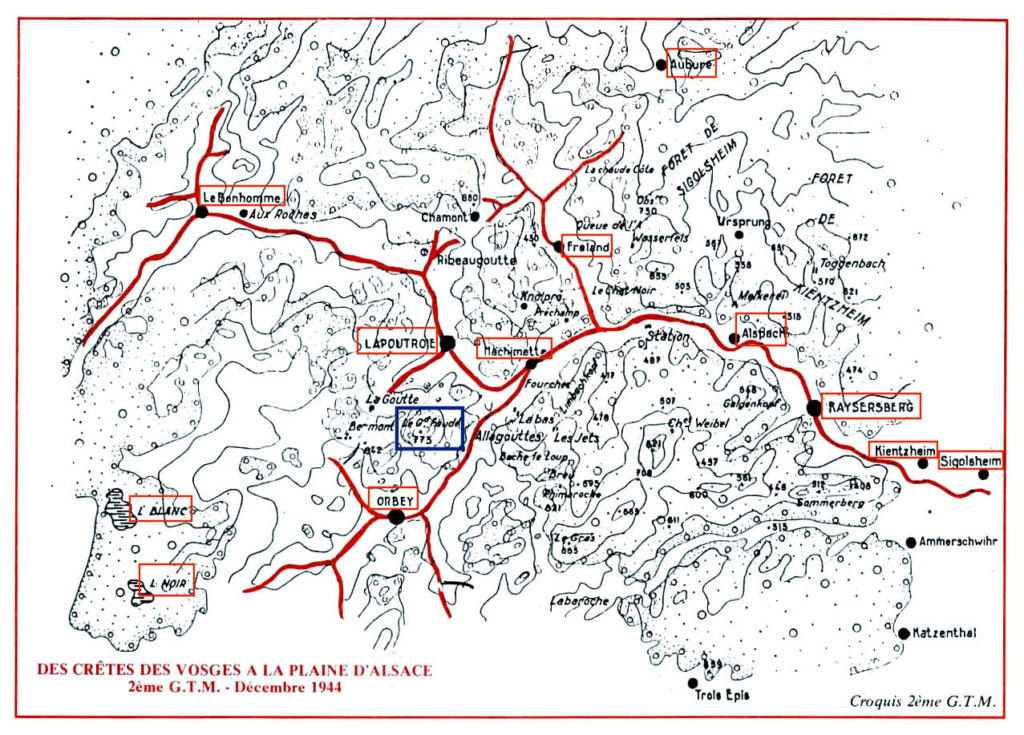
Orbey was liberated on December 16 and Kaysersberg on December 18, 1944. Made available to the 3rd DIUS, the 2nd GTM’s mission was to clear the Kaysersberg national forest. On December 31, 1944, the 2nd GTM was at the limit of its strength, with 900 men out of action, and was relieved by a unit of the 3rd DIUS.
After a well-deserved rest, the 1st Tabor was attached to the 2nd DB behind Sélestat (67) on January 20, 1945, the 15th Tabors to the 1st DFL and the 6th to Villé (67). In the final phase of the definitive reduction of the Colmar pocket, they liberated Muttersholz (67), Hilsenheim (67), Ehrwihr (67), cleared the Illwald forest and reached the Rhine at Diebolsheim (67) and Schoenau (67). From February 4, the Goumiers are rested in the Val de Villé (67)…the end of fighting in Alsace before their participation in the German campaign.
Moroccan goumiers are soldiers belonging to goums (light infantry units of the African Army, 80% of whom are Moroccan soldiers under the supervision of French officers and non-commissioned officers).
These units have existed since 1908 (and until 1956).
The Groupement de tabors marocains (GTM) corresponds to a Regiment made up of 3 Tabors. During the Second World War, each GTM comprised around 3,000 men, including 200 officers and non-commissioned officers. The 4 GTMs constituted an army force of 12,000 men.
From 1942 to 1945, the Goumiers Marocains distinguished themselves during the Italian campaigns (as part of the French Expeditionary Corps – CEF) and the French and German campaigns, where they earned 17 collective citations in the Army Order and 9 in the Army Corps Order.
The 2e groupement de tabors marocains (2e GTM) is, after the 2ème Régiment de Chasseurs Parachutistes (2 RCP), one of the 6 most decorated French infantry units of the Second World War, along with the 3ème Régiment de Tirailleurs algériens ( 3 RTA), the 4th Régiement de Tirailleurs Tunisiens (4 RTT), the Régiment de Marche du Tchad (RMT), the 13th Demi-Brigade de Légion Etrangère (13 DBLE) and the Bataillon d’infanterie de marine et du Pacifique (BIMP).
Between 1943 and 1945, the 4 GTMs were formed as follows:
1er GTM : colonel Georges Leblanc
2e tabor : 51e, 61e et 62e goums
3e tabor : 4e, 65e et 101e goums
12e tabor : 12e, 63e et 64e goums
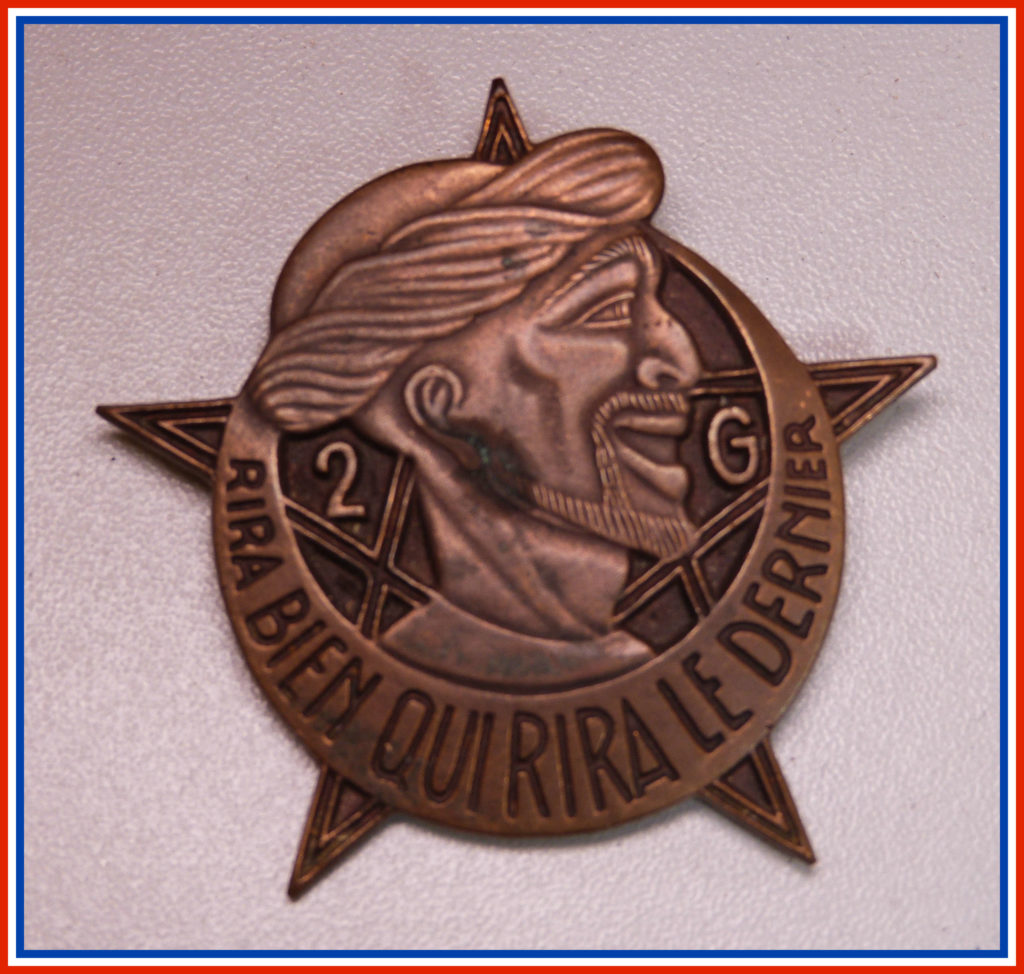
Since leaving Morocco, the 2°GTM has suffered severe losses:
450 officers, non-commissioned officers and goumiers killed or wounded in Tunisia.
336 killed and 2027 wounded during the French campaign.
2nd GTM (did not take part in the CEF’s Italian campaign, but only in those of Corsica and Elba in September-October 1943, then France and Germany): Colonel Boyer de la Tour
1er tabor : 47e, 58e, 59e et 60e goums
6e tabor : 36e, 72e, 73e et 74e goums
15e tabor : 8e, 11e, 30e et 39e goums
3e GTM : colonel Jacques Massiet du Biest (Provence Landing)
9e tabor : 81e, 82e et 83e goums
10e tabor : 84e, 85e et 86e goums
17e tabor : 14e, 18e et 22e goums
4th GTM (sent back to Morocco after the Italian campaign and did not take part in the French campaign. It was re-established in December 1944 for the German campaign): colonels Soulard, then Gautier and finally Parlange (from November 2, 1944).
5e tabor : 41e, 70e et 71e goums
8e tabor : 78e, 79e et 80e goums
11e tabor : 88e, 89e et 93e goums

O’NEAL…???
CUP, M-1910, aluminum quarter dated 1941 manufactured by T.A.C.U.Co for The Aluminium Cooking Ustensil Company headquartered in New Kensington, Pennsylvania.
It was engraved by an American soldier whose name is O’NEAL but of whom we know nothing to this day apart from what he engraved on his watch.
It certainly refers to the towns he passed through (in combat or not?), in what circumstances we don’t know.
On the other hand, the names of these towns have not been engraved chronologically:
VIENNE: if in Isère, liberated on 1/9/1944, if in Austria, captured on 13/4/1945.
BOLOGNA: liberated on 4/21/1945
FLORENCE: liberated on 11/8/1944
ROME: liberated on 4/6/1944
NAPLES: liberated on 1/10/1943
BONIFACIO: liberated 9/21/1943
MARSEILLE: liberated on 8/28/1944
DIJON: liberated on 11/9/1944
NANCY: liberated on 15/9/1944
STRASBOURG: liberated 11/23/1945
This quarter was in the belongings of Edgar Oberlin, a Colmar native who was drafted into the German army but was able to desert in Italy and join the 1st French Army – donated by Mrs. Oberlin to the Musée Mémorial.
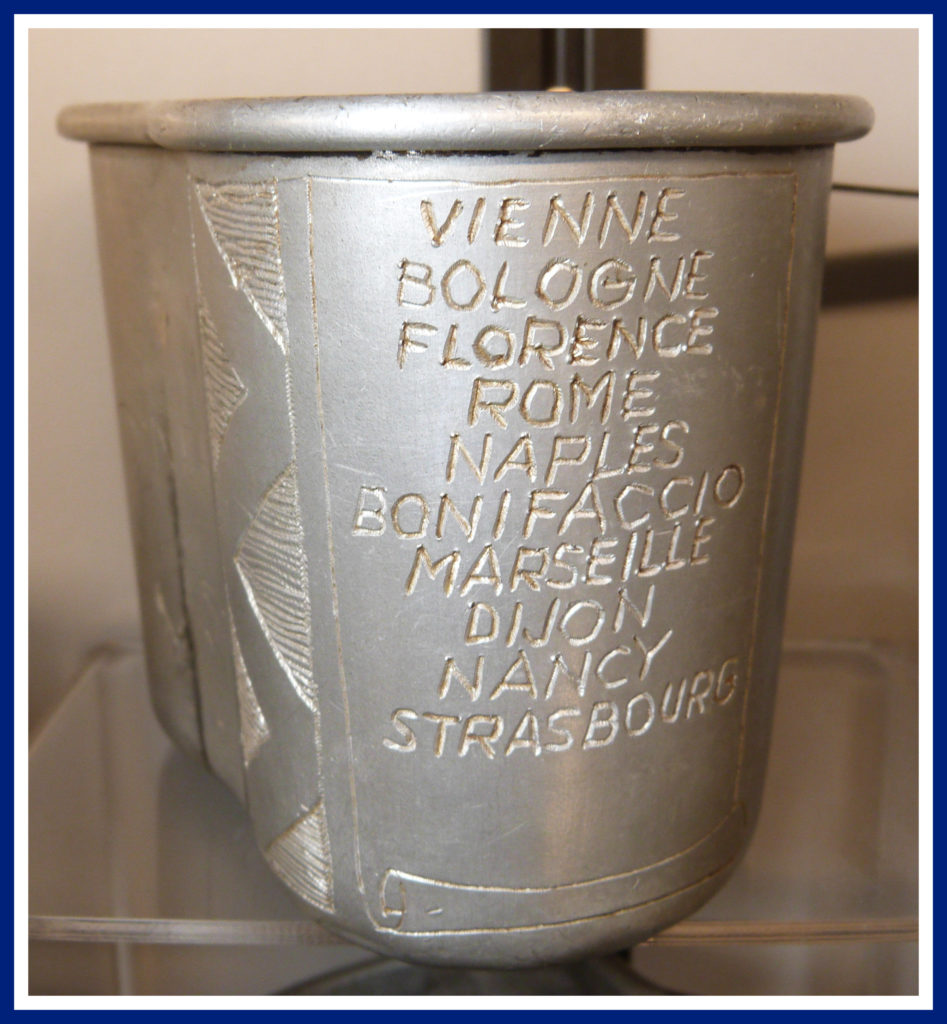
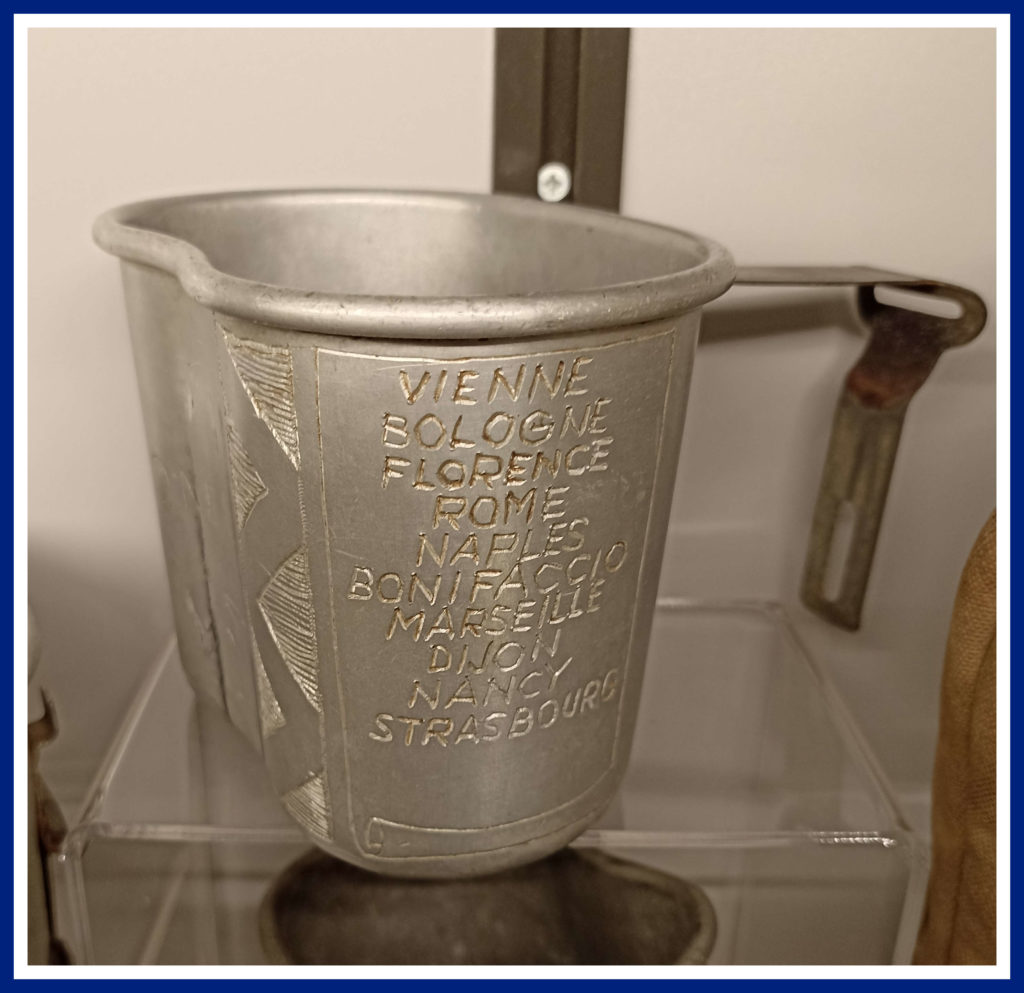
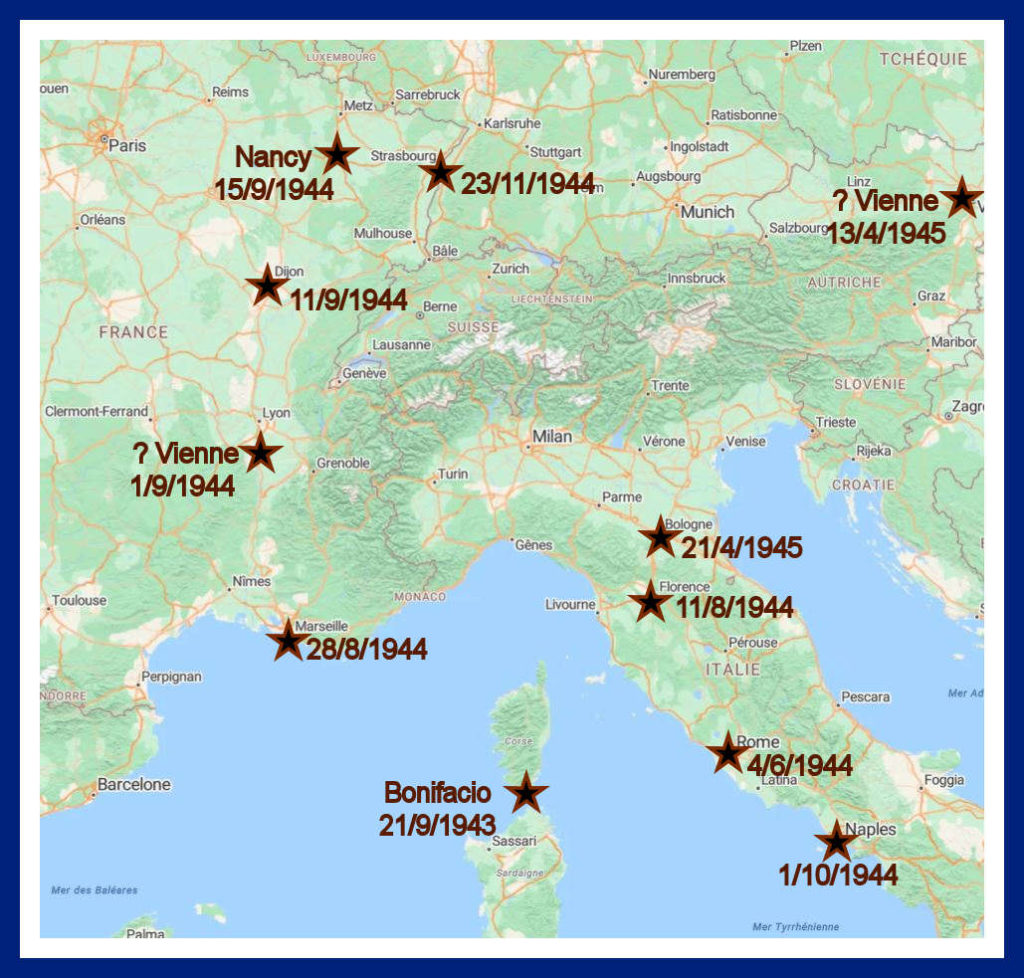
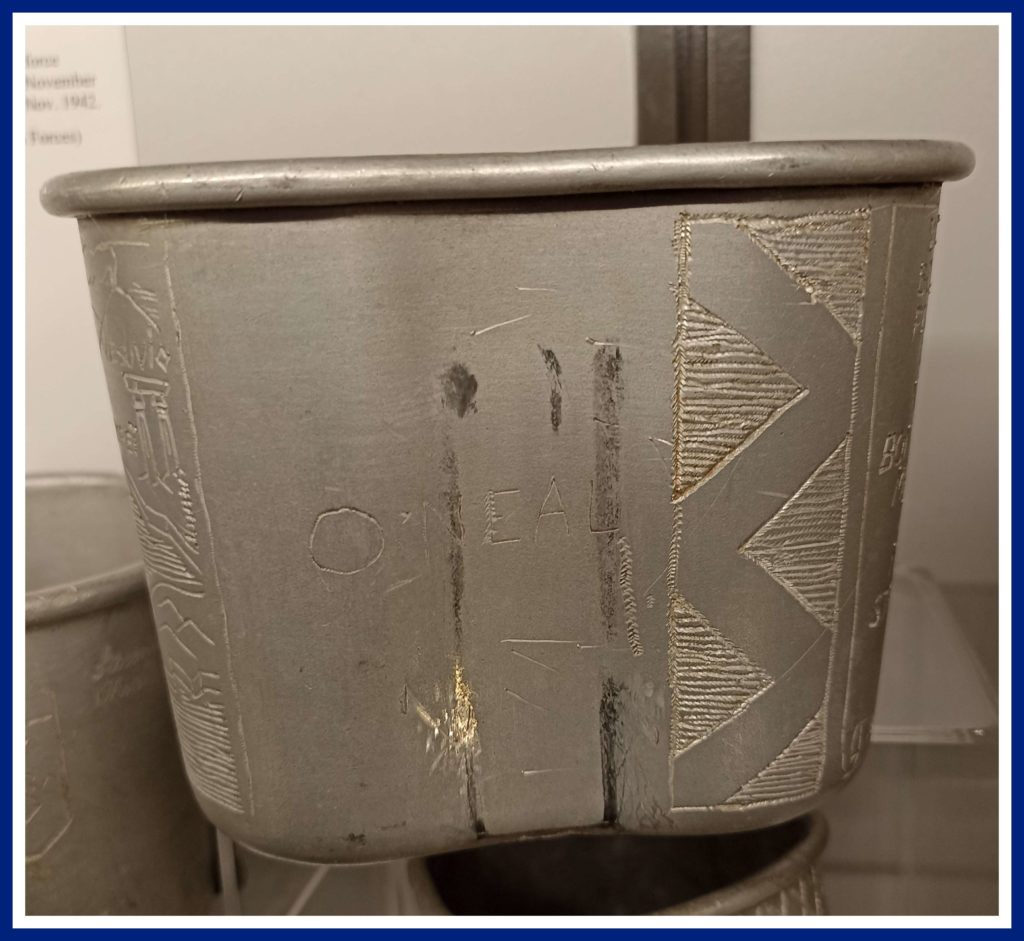
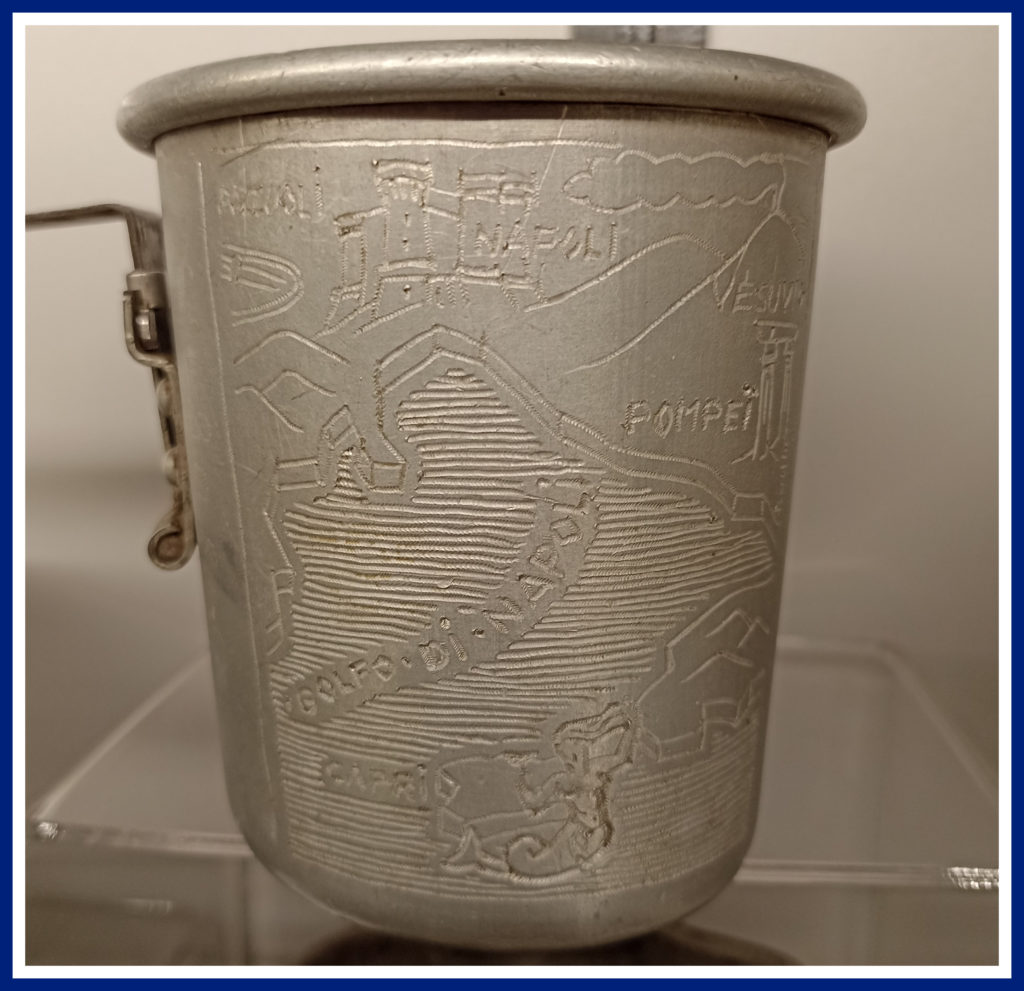
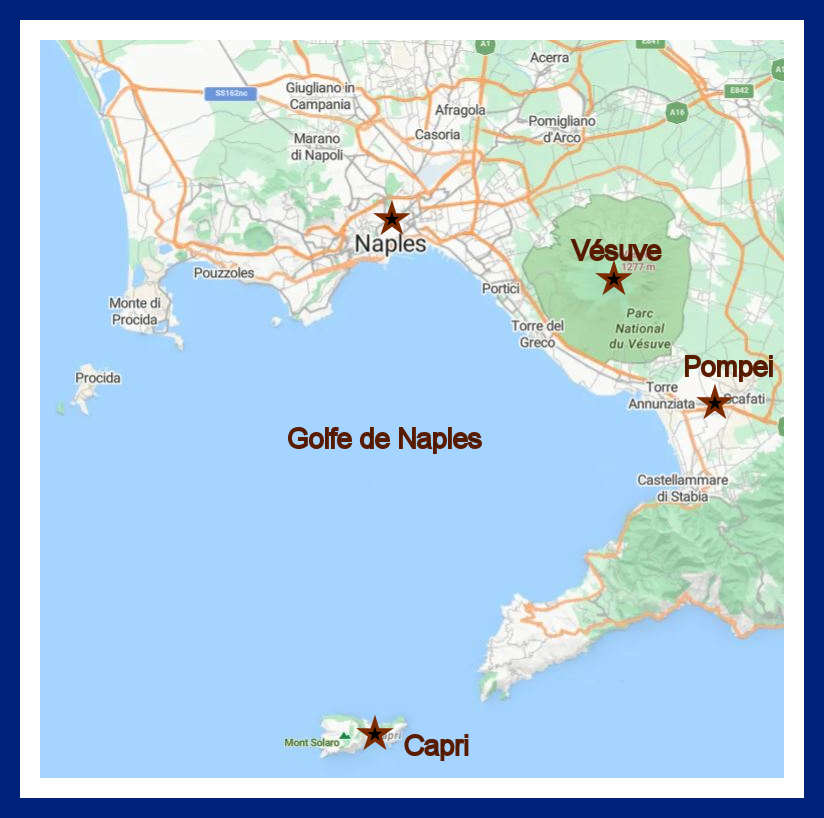
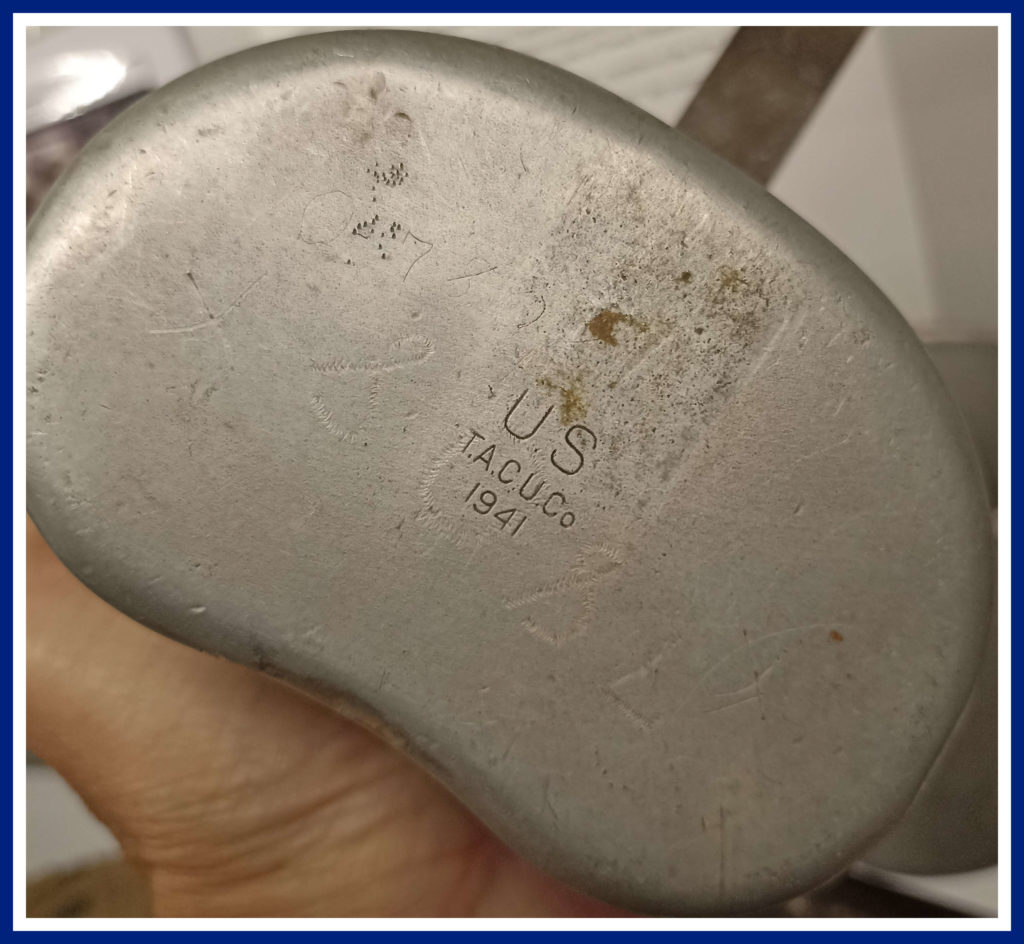
Schützenmine 42 (Schü.Mi. 42).
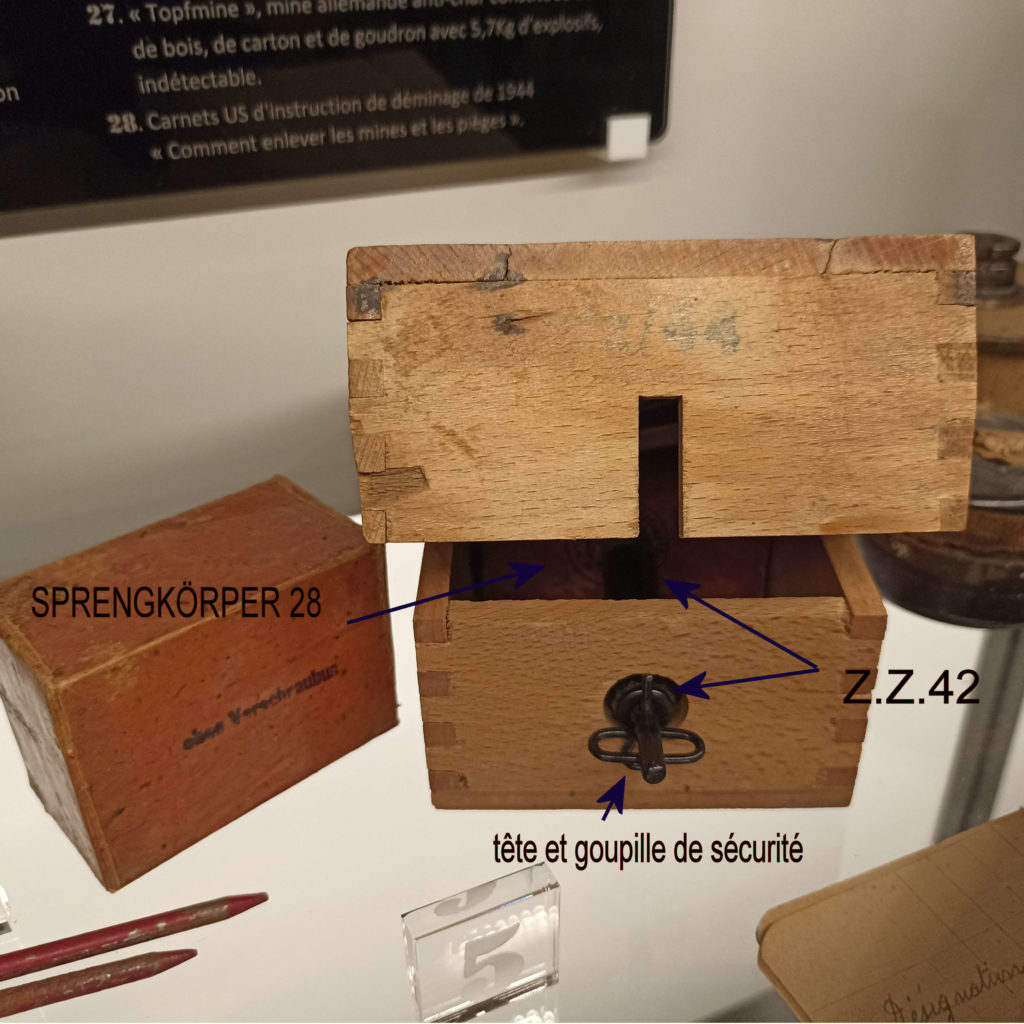
These are anti-personnel mines with low production costs.
Easy to manufacture in very large numbers and to transport, they also have the advantage of having very little metal… which makes them very difficult to detect.
It can be buried in the ground and covered lightly with sand, earth or snow, or even under a floor.
Made from a variety of materials (wood, plywood or compressed wood fibers), the Shü.M.42 is a simple box whose hinged lid opens to accommodate a Sprenkörper 28 with a well (200g Sprenkörper 28 demolition charge) into which a Z.Z.42 igniter is inserted, with its head and safety pin passing through the slot (on the front of the mine).
Operation of the mine is very simple: a pressure of 3 to 5 kg on the cover is enough to push out the safety pin of the Z.Z.42 igniter, instantly triggering the explosion.
The blast is sufficient to cause serious injury within a radius of 2 to 3 m.
The main objective is to immobilize a SOLDIER by mutilating his foot, “forcing” 3 or 4 other soldiers to take care of him and thus not to fight; not to mention the psychological shock created by the sight of a seriously wounded comrade.
Depending on the manufacturer, it has approximately the following characteristics:
length 12.7 cm,
width 9.5 to 10.5 cm,
height 5.5 to 6 cm.
Total weight around 500gr (empty).
